new posts in all blogs
Viewing: Blog Posts Tagged with: Self-publishing, Most Recent at Top [Help]
Results 1 - 25 of 300
How to use this Page
You are viewing the most recent posts tagged with the words: Self-publishing in the JacketFlap blog reader. What is a tag? Think of a tag as a keyword or category label. Tags can both help you find posts on JacketFlap.com as well as provide an easy way for you to "remember" and classify posts for later recall. Try adding a tag yourself by clicking "Add a tag" below a post's header. Scroll down through the list of Recent Posts in the left column and click on a post title that sounds interesting. You can view all posts from a specific blog by clicking the Blog name in the right column, or you can click a 'More Posts from this Blog' link in any individual post.
By
Jaclyn Dolamorefor
Cynthia Leitich Smith's
CynsationsI've moved into indie publishing lately, where it is entirely my choice which books I release into the world. So, I've been thinking about branding.
One thing it has taken me a while to realize is that just because you don't write the most popular thing and you get some bad reviews because of it, doesn't mean you need to change anything.
My second novel,
Between the Sea and Sky (Bloomsbury, 2001), is my favorite of my published books. Its review average on Amazon and Goodreads was never great, which initially made me feel like there was no place in the world for what I most love to write.
However, as the years have gone by, I've gotten many fan letters for that book from both kids and adult women who tell me it's one of their favorite books and they've read it many times. It took me all those years for the fan mail to trickle in before it finally dawned on me that it is the most beloved of all my books, as far as I can tell.
My brand is: cozy romantic fantasy about a couple in healthy relationship with lots of details about food, clothes, and domestic life, and bits of humor. The fantasy backdrop is more in the "courtly politics" vein rather than physical action, although there is a little of that.
The characters are always somewhat on the fringe of society, your lovable outcasts and weirdos, and if I've done my job, you keep reading because you find the characters delightful and you want to know what happens to them and see them find a place in the world.
 |
| Betsy the Cat |
They are the kind of books you might read when you're sick or having a bad day; where the characters are friends, the world is home, and you can trust that your heart won't get ripped out of your chest.
A lot of readers like having their heart ripped out of their chest. They give me reviews that say they wanted more action, more magic, more highs and lows. It's always tempting to listen to the bad reviews instead of the good.
And sometimes I love reading stuff that is epic, sweeping, dark. But when I try to write it feels like when I wear my disco dress with the fluttery sleeves. I love that dress but it just isn't
me the way my plain 1960s navy blue librarian dress is.
Other people might even like the disco dress better, but it doesn't matter, I still would be happier living in the librarian dress.
As a reader, too, the cozy reads are the ones that fall apart on my shelf, because I pick them up again and again. So I realize now that it is more important to keep writing books that are the most me, and retain those readers who appreciate them too, than it is to try and chase the next big fantasy bestseller.
Cynsational NotesJaclyn's books include:
- Magic Under Glass (Bloomsbury, 2009);
- Between the Sea and Sky (Bloomsbury, 2011);
- Magic Under Stone (Bloomsbury, 2012);
- Dark Metropolis (Hyperion, 2014);
- Glittering Shadows (Hyperion, 2015);
- The Vengeful Half (Self-published, 2016); and
- The Stolen Heart (Self-published, 2016).
Valuable article with link from Colleen Higgs about the difference between self-publishing and being published by a
publisher - by Arthur Attwell
The
problem with self-publishing
medium.com
What
self-publishers lack is not skill, but the relationship between an author
and a publisher
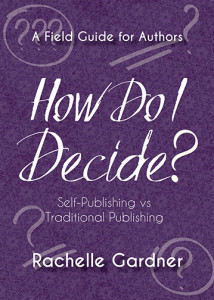
Did you know I have an e-book available on Amazon?
How Do I Decide? Self-Publishing vs. Traditional Publishing can help authors figure out which path to take.
How Do I Decide? is a concise, definitive resource that will guide you through the decision, allowing you to ignore the noise and hype and focus on the right path for YOU. This is a fair and balanced approach that avoids favoring one choice over the other—and instead shows you how to determine which best fits your own situation.
About 50 pages jammed full of insider information, How Do I Decide? gives you the facts you need to make an informed choice. It walks you through the various steps of the publishing process so you can determine which road best suits your personal goals, temperament, and level of previous publishing experience.
How Do I Decide? is brief yet comprehensive, and includes:
• an overview of the current publishing landscape
• an outline of the path to publishing
• a user-friendly checklist to help you figure out your path
• pros and cons of traditional publishing
• pros and cons of self-publishing
SPECIAL FEATURES:
• An eye-opening infographic that’ll help you decide
• A “quiz” to streamline your decision-making process
• Additional resources with links to further information
The e-book is only $2.99 on Amazon. Check it out if you’re considering which path to take!
(Cover design by the fabulous Nicole Miller.)
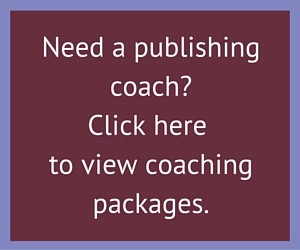
The post Traditional or Self Publishing? appeared first on Rachelle Gardner.
By
Linda Covellafor
Cynthia Leitich Smith's
CynsationsThinking of going indie?
Self-publishing can be a fun, exciting, and rewarding endeavor. But get ready for an eclectic collection of hats, because you’ll be wearing many. It’s important to realize you’re selling a product that should be of the highest quality.
Here are some tips and resources to help you through the process.
EditingBy the time you’re ready to publish, you should have already gone through developmental editing of concept, character, and plot issues. Now, you need a proofreader/copy editor.
Don’t rely on a random friend or relative. Keep self-published books a strong and respected force in the market by having your manuscripts edited professionally or by a trusted, experienced critique partner. (Whenever you hire an outside service, be sure to have a contract.) See my
list of editors from author recommendations.
Tip: Other indie authors can be a great resource for any self-publishing questions.
Cover DesignYour cover should be unique while blending with other books in your genre (a fine line to walk).
There are three cover options:
DIY: Royalty-free images are available online, such as
this site, which you can use to design your cover.
Pre-made covers. Google
“pre-made book covers,” and you’ll find quite a few.
Custom cover design. I’ve compiled a
list of recommended cover designers.
Bibliocrunch and
Girl Friday Productions offer editing, cover design, and other help for indies on a budget.
ISBNDo you need an ISBN (International Standard Book Number)?
Not necessarily, but most retailers and publishers require one. (Amazon.com does not.)
With an ISBN, your book will be more discover-able by readers, bookstores, and libraries.
Currently the price for an ISBN (purchased through
Bowker) is $125—not cheap. And you need one for the ebook and paperback of each title. If you plan to publish several books, you can buy them in bulk at greatly reduced prices; they never expire. Some businesses buy ISBNs in large quantities so they can then sell them at reduced cost.
There’s some controversy about the validity of these or “free” ISBNs, so obtain one from a reputable source. See Joel Friedlander's
article on ISBNs and the
ISBN website.
Formatting and PublishingDepending on where you decide to publish your book, you may need help formatting your manuscript. It’s free and easy to publish ebooks through Amazon’s
Kindle Direct Publishing (KDP), and they accept Word docs. Amazon’s print service,
Createspace, is free and requires only a PDF. They also offer professional publishing services.
Smashwords is an ebook publisher, accepts Word docs, but has a style guide that must be followed.
Smashwords has distribution agreements with all major online retailers and with
Baker&Taylor, which libraries use to purchase books.
Draft2Digital publishes ebook and print books. They accept simple Word docs with no style guide to follow. They offer editing and cover design as well, and distribution agreements.
Smashwords or Draft2Digital? Here’s
one blogger’s analysis.
IngramSpark is a print and ebook publisher with distribution agreements. They have a style guide to follow, and you may need a professional formatter. See blogger Linda Austin on
IngramSpark vs. Createspace (
book doctor Stacey Aaronson says it’s beneficial to use both)!
PricingTo price your book, check other books in your genre. A common price for ebooks is $3.99.
The freebie can be a good marketing tool when you have a series: offer the first book for free in the hope that the reader will buy the other books in the series.
Experiment with pricing; see where that “sweet point” is. Just remember, you’ve worked hard and deserve to be paid a reasonable price.
Marketing and PromotionOnce you’ve published your book, the real work begins. As an indie book publisher, marketing and promoting is a never-ending job! Here are some tips and resources:
Local schools, libraries, and bookstores. Ask if libraries and bookstores will carry your book. Contact schools to do author visits.
Author Alexis O’Neill’s blog is a great resource on school visits.
Subscribe to newsletters for publishing news, tips, classes, freebies, and generally “knowing your industry.” Some good ones are:
Follow blogs, including those of your favorite YA authors. If you use Wordpress, you can follow tags in your reader to find others with similar interests. Good blogs for self-publishing include:
- Chris McMullen. Lots of info on Amazon, other self-publishing tips.
- Bookbaby (another ebook and print book publisher). They had a recent Twitter chat with YA author Lauren Lynne.
- IngramSpark has a blog on their website with self-publishing information.
- Of course, Cynthia’s blog, Cynsations!
Guest blog on YA authors’ blogs. Most bloggers love having guest posts. Come up with an interesting topic and ask!
Join
SCBWI (Society of Children’s Book Writers and Illustrators), check the website for resources, sign up for their newsletter, and get involved in your local chapter (you can join forces with other authors for book signings, etc.).
Use Social Media- Get your books noticed through accounts on Goodreads, Facebook, Twitter, Google+, Pinterest, Instagram, and other social media sites.
- Join some young adult author and reader groups on Facebook and Goodreads to meet and learn from other YA authors, and to expose your books to readers.
- Create a website. Pay someone or DIY with sites such as Wordpress.com and Wix. This article showcases some “stellar” author websites.
ReviewsIt’s tough for indie authors to get reviews. Ask for reviews on your website and social media. Put a request at the end of your books. Here’s one
list of bloggers who review books. Though the title says middle grade literature, most will also review YA books.
 |
| Ginger |
Do a blog tour (usually done when your book is newly published), and many of the bloggers will review your book. These businesses, among others, handle blog tours. Some specifically target YA audiences, but be sure to pick a blog tour company that lines your book up with YA bloggers.
Enter contests. Prizes can add credibility to and exposure for your books. There are many
free contests and others, such as
RONE,
Chanticleer, and
Literary Classics, have entrance fees. These three all have YA categories. And, of course, there are
the biggies from ALA. See which awards accept indie books.
Advertise. Occasionally having a sale on your book and advertising can help boost visibility. Advertising prices and results vary. Most, if not all, of
these promotional sites have YA categories. Missing from the list, but popular with authors, are
The Fussy Librarian and
Bookbub (expensive, but results can be worth it).
Self-publishing has lost its earlier stigma of “vanity publishing,” and readers are embracing indie authors and their books. Indies have discovered the advantages of self-publishing: control over content and cover design, higher royalties, and quicker time to market.
Do the research, put out a quality product, work on marketing, and you can find success and satisfaction as an indie author.
Cynsational NotesLinda Covella’s varied background and education (an AA degrees in art, an AS degree in mechanical drafting & design, and a BS degree in Manufacturing Management) have led her down many paths and enriched her life experiences. But one thing she never strayed from is her love of writing.
Her first official publication was a restaurant review column for a local newspaper. But when she published articles for various children’s magazines, she realized she’d found her niche: writing for children. She hopes to bring to kids and teens the feelings books gave her when she was a child: the worlds they opened, the things they taught, the feelings they expressed.
She is a member of the
Society for Children’s Book Writers and Illustrators (SCBWI). She lives in Santa Cruz with her husband, Charlie, and dog, Ginger.
No matter what new paths Linda may travel down, she sees her writing as a lifelong joy and commitment. Find Linda at
Facebook,
Twitter,
LinkedIn,
Goodreads,
Pinterest and
YouTube.
Self-publishing giant Smashwords has signed new e-book distribution agreements that will help authors get their books in the hands of more global readers.
Back in October, the company partnered with Gardners Books to bring Smashwords titles to libraries across the U.K. Now, the website has expanded its e-book distribution network even further with new partnerships with Tolino, Odilo and Yuzu.
The Tolino partnership will put Smashwords e-books into several of Germany’s largest e-book retailers including: Thalia, Welbild, Hugendubel, Der Club, Bücher.de, meine BUCHhandlung, eBook.de, and derClub.de. The Odilo deal will expand Smashwords’ library distribution to 2,100 libraries in 43 countries across Europe, Latin America and North America. The partnership with Yuzu will help self-pubslihed authors reach the education market. Powered by Barnes & Noble College, Yuzu powers digital e-books across 473 college bookstores.

By: Kenneth Kit Lamug,
on 11/11/2015
Blog:
RabbleBoy
(
Login to Add to MyJacketFlap)
JacketFlap tags:
comic book trailers,
creative ideas and tips,
film trailers for books,
marketing for books,
social media marketing for books,
trailers for books,
self-publishing,
how-to,
Press,
book trailer,
book promotion,
Void,
instructables,
Add a tag
What is a book trailer and how can I get one?
Book trailers have become a popular part of modern book marketing campaigns. Just like movie or television show trailers, they are a great way of creating buzz and excitement for your soon to be best-selling book. There are many approaches to creating a successful trailer and I’ll be sharing with you some of my ideas.
But do book trailers really work?
Heck Yes, they do! Readers just don’t read… they watch, listen and immerse themselves in the audio-visual nature of popular culture.We live in a multimedia engulfed society, and neglecting visual-audio presentation tool is a big disadvantage to anyone working towards a career in writing and the arts. You are after all a story teller… and creating trailers is just one way of enhancing your audiences experience and emotional connection with the story. In addition, book trailers are great tools for sharing via social media due to its “stickyness” factor.
So let’s get on with it.
First thing is coming up with a plan for your trailer. What kind of trailer are you thinking of creating? What is your budget?
In this post we’ll talk about the different kinds of book trailers. I’ve broken it down into three easy to digest categories.
Let’s take a look.
Live action book trailer
These are the type of trailers that we typically see in movies. You’ll be working with real actors, directors, and video editors to create this slick production. This trailer works great if you want to create a realistic portrayal of your story. Just like a movie, you will have to cast the right actor to portray your characters and find a production team who will transform your vision from paper to screen. Bad acting and sloppy filming can negatively impact your presentation. So you might want to stay away from your nephew with a camera phone (Unless you’re going for that gritty camera phone look).
Think of your costs when producing a live action trailer… you’ll need to budget for actors, make up, equipment, costumes, video editing & production time and even location.
Try reaching out to your publishing company first and see if this type of production is in the budget. The alternative is to reach out to freelance artists or smaller firms who can create your trailer without breaking the bank. This usually means you have to slim down on your visual effects and only film the main scenes that will create the best impact with your audience.
Some writers like to go this route because they can also use the trailer as a tool for pitching their books to movie studios or producers. Not a bad idea, if you ask me.
Graphical trailer
These trailers are primarily composed of typographic and graphic animations with music and voice overs. Think of a slideshow on steroids. You can still create a fantastic trailer without having to blow out your marketing budget. I see a lot of books opting this direction and have done it with great success.
Going this route doesn’t necessarily mean that your trailer has to be a canned production. You can still personalize the trailer by using your own images, photography, and music. And if you’re working with a really good video editor, he can add motion that will make your trailer come to life as good as a live action trailer.
Keep in mind that audio plays a large part in creating the atmosphere of your trailer. Using sound and music properly can “mask” certain elements that you don’t show on screen. For example, in movies they will often use the sound of airplanes to create a airport scene… without showing the airplane itself. Think creatively!
Animated trailers
Animated trailers are a little in between live action and graphic trailers. It’s a mix of motion and movement with the use of animated characters… yet it doesn’t necessarily mean that it takes less time or money to produce.
It is also specialized in a way that it will probably be more effective for certain types of books (for example, children’s books or graphic novels and comics). Instead of actors, you now have to animate drawn characters and background scenes.
If you’re trying to create this type of trailer for a book that doesn’t utilize existing artwork (such as comics), then you will need an artist who will translate your stories and characters into a visual medium. Artists varying styles can also affect the atmosphere of your trailer, make sure to find someone who can portray the emotions you want.
Another factor to consider is how much control you want over the direction of your trailer. If your publishing house is producing the book trailer, they might want to hire a professional team who will create a script that works best to sell your book.
If you’re doing it guerrilla style (that means indie), then you have more control over your production. But at the same time you take on more of the burden and the responsibility for the end result — good or bad. Not everyone can be a director, yet with enough studying and dissection of existing trailers, you’ll slowly see the formula on how it’s done.
In the next blog post, I’ll talk a little bit more about the process of creating book trailers!

By:
Heidi MacDonald,
on 8/18/2015
Blog:
PW -The Beat
(
Login to Add to MyJacketFlap)
JacketFlap tags:
Comics,
Retailing & Marketing,
Webcomics,
self-publishing,
Process,
Breaking News,
POD,
print on demand,
E-publishing,
kickstarter,
Top News,
Crowdfunding,
Top Comics,
Controversy!,
Add a tag
A little while back, Brian Hibbs wrote a piece involving the place of Kickstarters in the comics world that still seems to be making the rounds online. It comes at it from the retailer angle, and as somebody who’s run a few Kickstarters, I have a few different thoughts about how crowdfunding fits into the […]
We all know that we need for our work to be copyrighted to protect ourselves from others profiting from our work, but what are the facts? Check out this Writer’s Digest article, “6 Questions Writers Ask about Copyright and the Law” by Chuck Sambuchino.
A good primer. The points that are covered:
- Do I need to register my work with the U.S. Copyright Office to hold a copyright on the work?
- So since I do not need to “super copyright” my work to have basic protection, is there any real incentive to doing so?
- I’ve heard that if I mail a copy of the printed work to myself, that proves copyright. Is that true?
- Does a copyright protect ideas?
- What are the legal ramifications of reproducing song lyrics in a manuscript? Also, can I use a song title as the title of my book? I have personal experience with this—I used song lyrics in my novel The Summer Boy and then either took them out, referred to titles, or otherwise referred to lyrics in ways that didn’t duplicate them exactly.
- In a work of fiction, what restrictions exist on using the names of professional sports teams, TV networks or real people?
Ray
© 2015 Ray Rhamey
Jas Ward, an author who has self-published five books in the Kindle store, is challenging Amazon with a Change.org petition after one of her readers was unable to post a review of her book on the site. The petition, which has already garnered more than 11,000 signatures is calling on Amazon to change its policy.
The issue began when reader Imy Santiago, who is also a self-published author, tried to post a positive review of Ward’s book on Amazon but was rejected. After multiple attempts of trying to figure out the problem, Amazon told Santiago that they couldn’t post the review, “because your account activity indicates that you know the author.”
“I have interacted with a couple hundred authors over the past year; from events to signings, authors and writers rub elbows during networking sessions. This does NOT mean I know you personally,” she complained on her blog.
“Your current process of removing reviews that a reader has created to show their honest & sincere opinion on a book is not fair and cripples the review process more than assists,” reads the petition.

By:
Heidi MacDonald,
on 6/28/2015
Blog:
PW -The Beat
(
Login to Add to MyJacketFlap)
JacketFlap tags:
Interviews,
Cartoonists,
Conventions,
self-publishing,
Indie Comics,
michel fiffe,
Top News,
self-publication,
HeroesCon,
COPRA,
heroescon 2015,
Add a tag
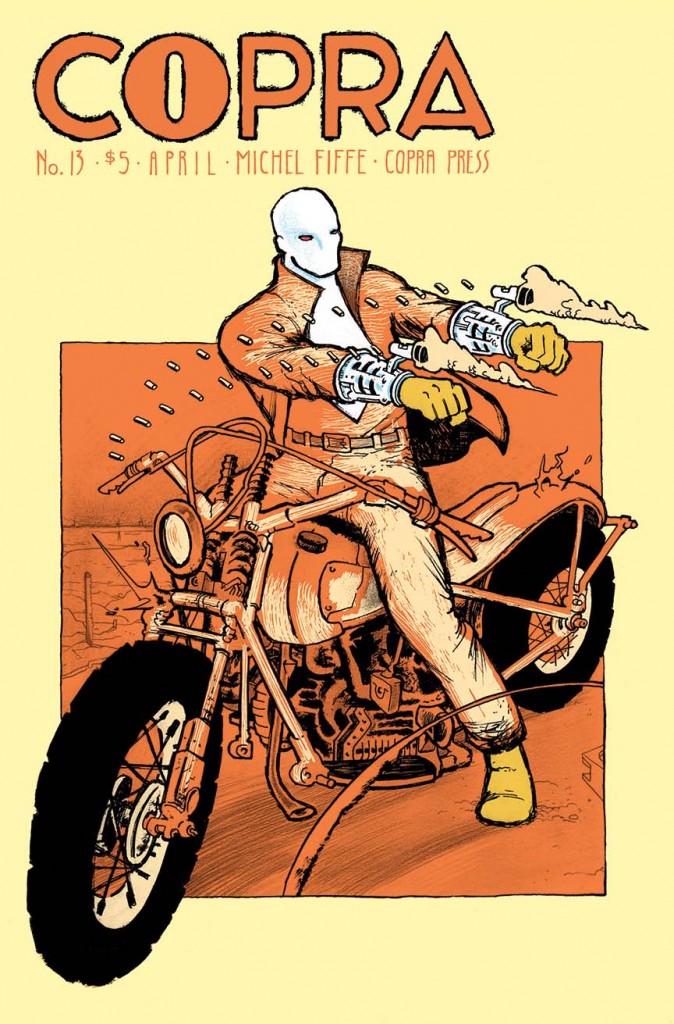
Continuing on from our first entry this past Friday, here is the second part of my HeroesCon interview with Michel Fiffe, creator of the self-published and much lauded action-adventure comic, COPRA.
It’s funny, the way I discovered your work actually came through a friend of mine at first, as a word of mouth sort of thing. Then I firmly jumped in when Oliver Sava starting writing about it on the A.V. Club, and you ended making a ton of these “Best of 2014″ lists, which is pretty exciting right? That sort of vindication has to be rewarding.
It’s nice, it’s nice that people like it, absolutely. Oliver’s a great supporter.
Everyone wants to make a superlative list at some point, right?
Yeah, that means a lot to me personally, and it actually translates into more readers. I think word of mouth has really worked a lot on COPRA, without any huge marketing muscle behind it. That’s been the primary thing, people are just excited about it, and that’s super flattering. To like it so much – in today’s aggressive marketplace – that they spread the word out of genuine enthusiasm… what more could you want?
That’s literally what’s happening, though the only hurdle is, of course, availability.
That’s the only hurdle right now. Bergen Street Press has been working hard for a couple of years now to get over it. We don’t want to make it super exclusive, this isn’t a super limited boutique item by any means, but it’s also not as simple as pushing a magic button for books to suddenly appear. Others have that magic button.

When you made the collections, which have obviously been a great way to pull in readers, you went with Bergen Street Press, and that’s Tucker Stone’s outfit right?
Yeah, that’s Tom Adams and Tucker Stone, they’re co-owners of the store, Bergen Street Comics and they started publishing and putting out “compendium” collections of the issues early on because I started selling out of the issues. So they met that demand, they helped me meet that initial burst of enthusiasm. I was too caught up creating the next issue. My financial model is that one issue pays for the next, there’s no room for reprints, that’s not within my budget. Bergen really helped make it more available and more accessible to people. The compendiums led to an official collection, the current “Rounds” as they’re called, which collects six issues at a time. That’s the kind of thing that we’re trying to get into all the comic shops across the country.
It’s showing up in stores in Atlanta, and I even think I saw copies in the UK over Gosh Comics perhaps.
Yeah, we get a lot of orders from all over the world.
Did you just have a relationship with Tucker and Tom, is that why you went with them as the distributor and publisher and go-to guys?
I trust them and respect them, and I couldn’t happier with that specific team of players. Their point of view and their involvement with the comics industry is something I can get behind.
In regards to availability though, is digital not in the cards?
It’s not NOT in the cards, it’s just something I still have to manage and deal with. There are just so many issues with it, the platform, the way it looks, the time to get everything in order. I’m still dealing with the print issues, that’s a huge thing for me, just getting one of these out every four to six weeks. I barely have any time to do anything else BUT this issue. When it comes to digital, I want to be as hands-on as possible, and that’s a time sucker. I wouldn’t rule digital out, but at the moment it’s not a primary concern. Having said that, I don’t want to exclude anyone from reading it, I understand there’s a large portion of the readership that’s gone digital because its more convenient, but personally I haven’t related to that model. So, it’s not a priority. I don’t feel like it’s something that’s burning in me to address anytime soon.
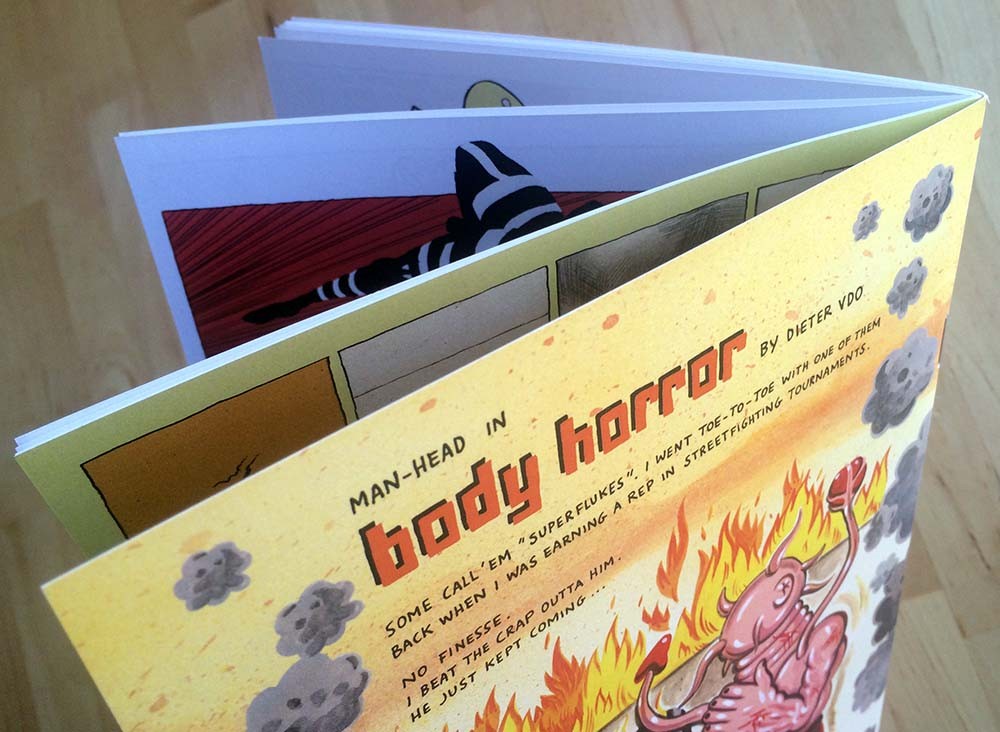
But there is an argument you made yesterday (on a panel with Klaus Janson) about the visual of the comic as a physical object. When you go digital, you do lose that. I mean, you can put everyone of those pages, including the back cover and back matter into a digital copy, but it’s not the same.
It’s not the same, and I want to be clear that I don’t want to impose my fetish of the newsprint comic on anyone. But readers do have the option to buy the issues or NOT to buy them, and that’s the risk I take. I’m not forcing people nor am I trying to change the industry “back to the glory that it was”. I’m just doing this because it’s a model that I’m familiar with and I aesthetically like. It’s a much more intimate thing. I just don’t read that many digital comics. That’s not how I absorb this stuff. I would feel weird putting it out in the world if I’m not sure of it myself.
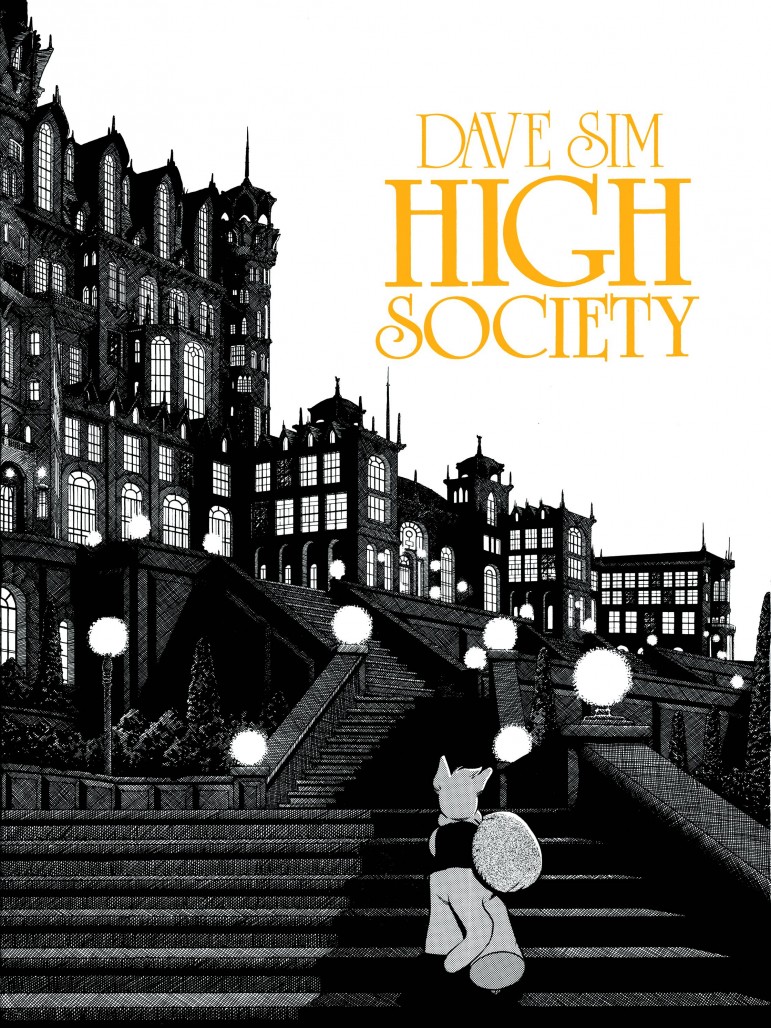
The comparison has been made, and COPRA has been compared very favorably to works like Cerebus, and that’s a comparison that I find to be really quite apt in that you’ve taken an analogous set of characters, like Dave Sim did with Conan the Barbarian, but by Round Three, you’ve expanded that world and its character set in a way not dissimilar from his work in “High Society”. Is that a comparison that you find interesting?
It is, mostly because Dave and I were born on the same day.
Really?
Yeah, so it just means we’re both stubborn and hard headed, and we’re gonna do what we want no matter what. But the COPRA/Cerebus thing… I imagine it’s more accurate than I’d like to think, but the main difference is that Cerebus started out as a parody. And my book…well, I personally fucking hate parody comics of that nature. I like Cerebus, but I especially mean modern indie takes on this sort of stuff. It’s low hanging fruit. You’re going to make fun of superheroes, good job, you’re wasting your precious time on earth doing that. Who cares? You’re not gonna outdo Marshal Law. I love that comic to death. There was a lot of anger behind that book, but it didn’t look down at anyone. Now, you either like superheroes or you don’t, and it’s perfectly fine to dislike it. In fact, you probably shouldn’t. I have zero interest in making fun of this stuff. From the first page of COPRA, it was serious business to me, serious business while fully realizing and basking in the absurd nature of this material.
That’s a difficult balance to achieve – seriousness without being overtly grim.
I just don’t want to wink at readers. I respect the readership too much to be winking at them – like, hey get the joke? Isn’t this DUMB? It’s like, fuck that joke, it’s a terrible joke. And I think Dave Sim wised up to it early on, because he was parodying Conan and the goofy barbarian genre, but then it took on a different identity all together.
 And I feel like that’s where you’re headed too. Round 3 is stunning, and I think when it hits a collected edition, I think there’s going to be a lot of talk. I don’t know how else to put it. I don’t want to speak too highly here, but I think that’s going to be when – people already notice it, but I mean, my god, that chapter when Wir goes back home…
And I feel like that’s where you’re headed too. Round 3 is stunning, and I think when it hits a collected edition, I think there’s going to be a lot of talk. I don’t know how else to put it. I don’t want to speak too highly here, but I think that’s going to be when – people already notice it, but I mean, my god, that chapter when Wir goes back home…
Yeah, that’s a favorite. I was worried about making that one too because it’s so bizarre, even within the norms of COPRA, you know?
It was so touching and so raw. It struck nerves for me. And then Gracie in Miami, and you’re working out some of your own feelings about the city and you even say as much on the back end.
Yeah. Every issue pretty much has at least one autobiographical component in it. And I find that interesting when I read older comics too, whether they meant it or not, I think it comes through. Especially for the older creators who really had no other option but to express themselves through The Brave and the Bold or something. But for me to actually write this stuff, I have to put some sort of personal experience in it. So every issue, there’s something there that’s really personal. But I also don’t want it to be too obvious, though.
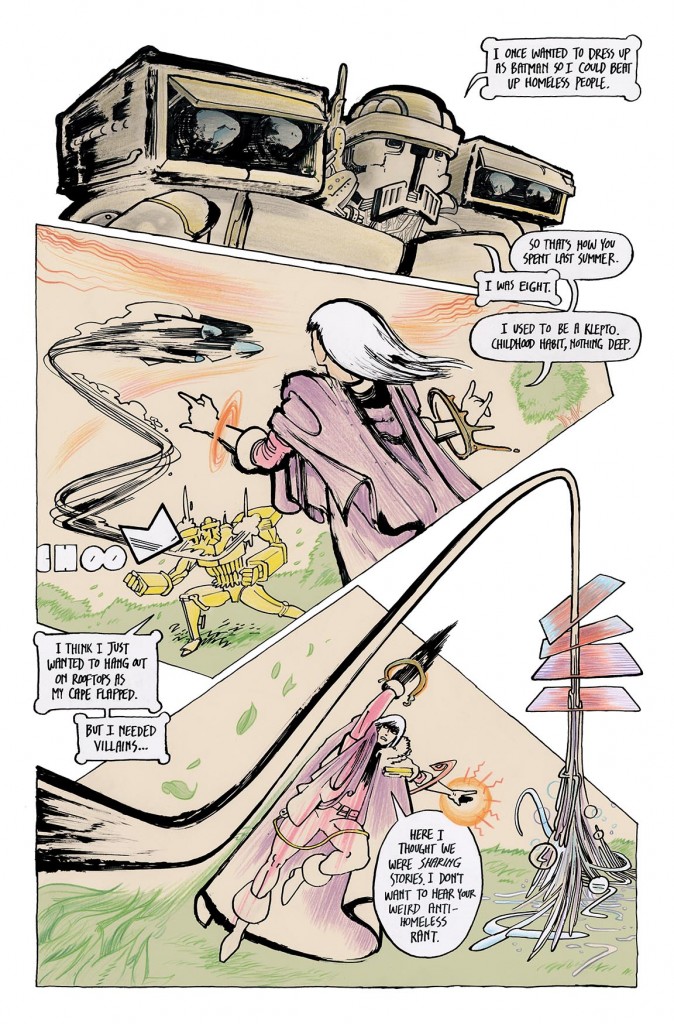 Let’s talk about Round Four or the presumed Round Four, about what’s coming up, what’s being developed. Spoiler alert: Dutch got it at the end of the latest issue. And clearly there’s another team that’s sort of gaining up on the COPRA side of things. At least that’s what it seems like. There’s an organized group of evil doers. What can we expect in the next couple of issues; I think there are two left in this round?
Let’s talk about Round Four or the presumed Round Four, about what’s coming up, what’s being developed. Spoiler alert: Dutch got it at the end of the latest issue. And clearly there’s another team that’s sort of gaining up on the COPRA side of things. At least that’s what it seems like. There’s an organized group of evil doers. What can we expect in the next couple of issues; I think there are two left in this round?
I have two left. And then I’m going to have a 25th issue anniversary-sized thing, that’s going to stand apart from the narrative, the main arc. And then starting with issue 26 that starts another arc all together. I’m going to work in six issue chunks, but there are going to be main storylines in that. I think I’m going to go up to fifty issues, so 25 will be an anniversary issue, as well as the halfway point.
So there will be an endpoint that’s set in stone?
Yes, I do have an ending set, I’ve mapped it out that far. I’m so excited for it. Knowing that it’s going to end and that everything is building up towards it makes every step of the way that much more fun for me, much richer.
So what can you tell me that we can expect in just very general terms, without spoiling anything, for the next two issues? Is it going to be a battle between the team and this group of guys that are coming after them?
It’s going to be COPRA vs COPRA. That’s all I’m going to say.
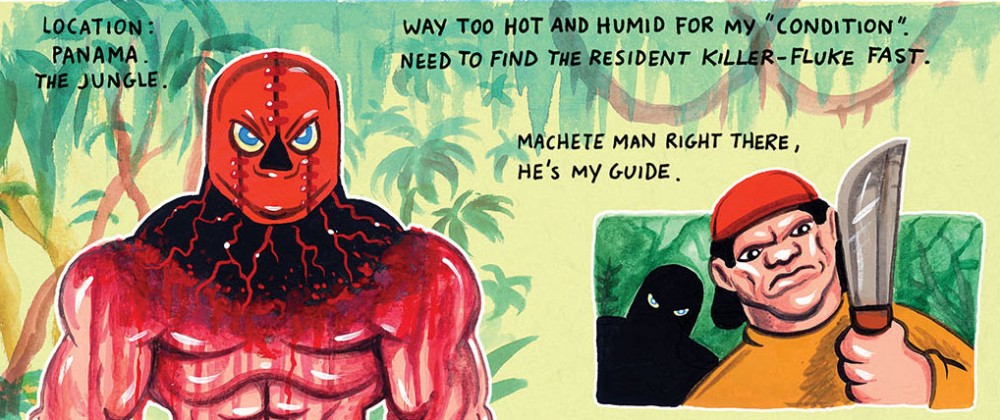
You’ve got two other narratives occurring in these books, you’ve got Dieter VDO’s back cover story for Man-Head…
Which is non-canonical.
Let me ask you how that got arranged first. Are you and Dieter friends?
Oh, I’m a big fan of his work. He did a Savage Dragon story for this collection of back ups I edited. This was ages ago. Anyway, Dieter… I like spreading the word on him. I think he’s great, one of my favorite cartoonists. I wanted to have unique back matter for this current arc and he was the first person I thought of to do something. Instead of pin ups, though, I wanted a serialized narrative. Thankfully he was on board. His own weird version of COPRA? Who wouldn’t want to see that?
So what is going on between your narrative and his narrative in these orange and white pages? There’s something appearing in the sky…?
Oh, that. Well, that’s a subplot that has to do with Rax’s dimension. It’ll all make sense once you read it together, there IS a point to it; it’s not as arbitrary as it seems. I’ve been playing it quietly because if I show too much, it’ll spoil things.
When can we expect the next issue to hit?
Maybe 4 weeks, a month? After the show I’ve to get back to drawing it. I’m not really ahead, schedule-wise. As soon as the issue is done, it’s practically in the readers’ hands.
You can purchase recent issues of COPRA at Michel Fiffe and Kat Roberts’ Etsy store. While Bergen Street Press is currently sold out of both collected editions of the series, you can purchase the first collection at InStockTrades.
10 Tips on Self-Publishing a Novel
Here are 10 tips and advice on how to self-publish your first book. Because so many new writers have emailed me asking for advice on self-publishing, I have decided it was time to write a post on it. Hopefully, it will help anyone wanting to publish his or her own work.
This is both my personal and professional advice on the “how to self-publish” a book easily and successively. This post does not cover every aspect of self publishing a book, but it does help with the basics. And ways to avoid a few mistakes.
TIP 1
Critique Partners wanted!
Obviously, first you need to write a book.
Then please, please, please, find a few good critique partners. I have a detailed post on this topic on my blog HERE. (But read this post first.) You can try to find beta readers too, but I personally find that unless they read the genre you write in, and they’re NOT your family or friends, they don’t offer much help.
Once you find a few CPs (critique partners) to exchange your manuscript with and get feedback on your storyline, do another round of revisions on your novel. I do at least 8 to 10 drafts on each of my novels before I feel it is close to being ready for publication or is in good shape to send to an editor.
TIP 2
Professional Editor Advice!
This brings me to my next point. Please consider hiring an editor. Now I realize that it can be expensive; however, I have found quite a few amazing editors over the years who were both amazing and inexpensive.
Put some money aside to hire someone. Self-publishing is a business and writers need to treat it as such. You must invest money into any new business venture and self-publishing is like starting your own company and selling a product—your book.
A lot of self-published books and writers are getting a bad reputation because of the lack of editing being done. You worked hard on your book, so invest some money into making sure it shines.
Some professional editors will negotiate their prices or let a writer do a payment plan. Don’t be afraid to ask. Also, get recommendations and a sample edit before hiring anyone.
I recommend getting two passes done on your manuscript (MS). Unless you’re a grammar wiz, you will need two edits.
The first pass should be a developmental edit (content editing) on the MS to go over areas such as these:
Conflict / Tension
Plot development
Character ARC / Goals
Show versus tell (Deep POV)
Writing Style (that fits the genre)
Opening and closing scenes
Point of view (POV)
Distinct Voice / Style
Pacing issues
Setting and descriptions
Backstory
Redundancies
Clichés
Dialogue exchanges
Point out repetition (including overuse of certain words or phrases)
Indicate clarity issues
A proofread/copyedit should be the very last thing a writer does, so I recommend that you wait until all the revision work has been completed. Next, a writer will need to do a copyedit, which includes such things as:
Awkward sentence structure
Grammar
Punctuation
Typos
Spelling
Fact checking
Tightening up wordy prose
Smoothing awkward transitions
Extensive rewriting
Check for consistency
Dialogue tags
TIP 3
Educate yourself!
With the Internet nowadays, writers have an abundance of information readily available. But it is apparent that the majority of newbie writers that ask for my advice have done little to no research on writing or self-editing, or even on how to self-publish.
It does make me a bit cranky. And it reveals to me that these writers are not that serious about publishing. Before I became an Indie author, I did a ton of research on the "hows" and "whys" and "costs" of self-publishing a book.
I spent hours looking into how to convert my docs into eBook formats, freelance editors, marketing plans, book cover design, etc.
And oddly enough, it seems as though many new writers will finish writing a novel without really studying the craft, or researching how to publish it. Even if they have done some reading on the subject of self-editing or creative writing, they haven’t applied it to their own writing.
If you are serious about wanting to self-publish your work, you need to research all aspects of the industry. Again, this is a business. Writers need to be constantly learning the tools of their trade by reading books on fiction writing, self-editing, and revision. Plus, marketing and promotion and branding.
Subscribe to blogs and websites that offer free advice (there are a ton of excellent ones!) Here is a list of the best blogs to follow and read Top Writing 25 Writing Blogs. Plus, follow the Positive Writer blog for words of encouragement and awesome writing advice.
Join writing groups and forums.
Follow writing / other writer's blogs. You can get some incredibly helpful advice from people who have had success self-publishing in this tough industry.
Join Twitter and do a search with this hashtag #WriteTip and you’ll find an amazing amount of wonderful writing advice.
TIP 4
Learn. Study. Research. Read!
If writing is your true passion, then educating yourself will be fun and maybe even eye-opening. Personally, I love learning new things about the writing process and how to better develop my skills.
Read extensively in the genre that you want to write in. If you want to write or publish a horror novel, then you need to read a ton of horror books. Study and absorb how other writers created suspense and scares.
Take some online writing classes. These can be expensive, but are very informative. If you can’t afford to do that, then I suggest going to YouTube and watching videos on the craft.
The first and most basic thing to do is to learn how to “plot” a novel. There are a lot of helpful books on this subject. Go to your local bookstore or favorite online retailer and buy some guidebooks on plot structure.
The plot is the skeletal structure of your novel, so that’s the first thing any good writer should learn how to master. Second, if you learn how the Character ARC ties in with your plot, and then you’re on the way to having a great book to share with your readers.
Also, a book that I'd recommend reading is "Writer's Guide To Character Emotion" to improve your writing skills by the use of the “Deep Point-of-View” technique, which can transform any novel from mediocre storytelling into riveting prose.
The more a writer learns about the elements of great fiction writing, the more developed their skills will become.
TIP 5
Converting Your Novel!
Once your book has been edited and revised numerous times, it is time to convert your document into the files needed to upload to publishing sites. I would use an online service that does the formatting and conversion on your behalf.
I highly recommend using bookow - http://www.bookow.com to convert your MS into professional looking eBooks and a print-ready PDF for print editions.
Or you can hire someone to do the conversion formatting for you. However, bookow is an inexpensive and easy-to-use choice, plus if you decide to revise anything in your MS after it’s published, you can just upload a new version into bookow without the hassle of paying someone to redo the conversion.
TIP 6
Places to Self-Publish!
To actually publish the MS once it has been converted into an eBook file, I recommend using only these two self-publishing sites: Kindle Direct Publishing (KDP) and Draft 2 Digital (D2D).
D2D is for publishing your work at all other online book retailers, such as Kobo, Barnes & Noble, and Apple iTunes, among others: https://www.draft2digital.com
All online eBook publishers will submit your book to everywhere in the world if you choose to select those countries.
A lot of writers use Smashwords, but they have strict policies and I think D2D is a much quicker and easier way to publish your book. Plus, I don’t know why, but to me, Smashwords screams, “I have a self-published book!” and a writer’s goal should be to have their eBook look as professional as any trade book.
TIP 7
Have a Print Copy!
With CreateSpace, a writer can easily access the tools needed for quality printing, and sell through booksellers worldwide, as well as having their book for sale on all Amazon channels throughout the world.
If you are “self-publishing,” the author retains all the rights with Createspace. And there’s no need to buy an ISBN number because Createspace does offer writers the choice of either a free one or the option of purchasing one from their site.
Plus, is nice to have a physical copy of your hard work, too.
I actually sell quite a few paperbacks, so I recommend having this option for potential readers.
TIP 8
Book Cover 101!
Now, let’s move on to the importance of book covers. I can spot a self-published book a mile away. A stunning cover can attract a reader’s attention and have them buying your book over the competition. It’s like the first impression that a reader has of your wonderful product.
Readers shouldn’t judge a book by its cover, but they certainly do. It’s probably one of the key areas that self-published writers fail at getting correct. If your book doesn’t look great on the outside, then people are going to be much less likely to buy it.
Take a good look at the book covers on Amazon and goodreads and get one done that fits the genre of your story. It might look generic to you, but trust me, it's more important for the cover to "look the genre" than to have one that is unique and/or evocative. My purpose is to help you sell more books. Period.
The cover of your book is the first thing people will see, so a writer wants to make sure that it looks professional. As far as designing a book cover, I strongly suggest NOT designing your own, but doing some detailed research on what is trending in the genre. After all, if your book doesn't look like what readers are searching for, it's very easy to go right past it to the ones that do look the way they expect them to.
If you need help deciding what type of cover design you need for your book, please go HERE
TIP 9
Back Jacket Copy that rocks!
Writing a catchy blurb (product description) is hard for a lot of writers. Consider how readers look for books. They browse through lists of novels, looking at the cover art and titles, and then the price and often the star rating. Then if those things have grabbed their interest, they scroll down the page and read the book description.
This is THE MOST CRITICAL point in the process for a potential reader. This is when they need to become intrigued, or hooked, into deciding that they must have this book. If they don’t, they click the back button and start looking for another book. And you’ve lost a sale, and possibly a long-time fan and reader, forever.
Whether you plan to self-publish or work with a publisher, it’s crucial to know how to create an appealing blurb for your book—one that’s compelling enough to entice a reader into buying your book. If you need help, I have more info on my blog HERE
TIP 10
Price matters!
I suggest that writers browse through the popular books in their genre at Amazon or any online book retailer and get an idea of pricing.
Many variables influence price. What is the page count? What is the competition selling at? All of these aspects must be considered when deciding on the retail price.
Studies show that a full-length, self-published novel at 50k words or longer should be priced somewhere between $2.99 to $4.99.
However, if you are new author without an audience or niche market, I suggest doing a promo price of $0.99 for the first few months until you build up a readership.
Now it’s time to start promoting!
I have a 9 Part Series on Book Marketing and Author Promotion that should help give your novel some instant noticeability. Start reading HERE

By:
Heidi MacDonald,
on 6/26/2015
Blog:
PW -The Beat
(
Login to Add to MyJacketFlap)
JacketFlap tags:
COPRA,
heroescon 2015,
Interviews,
Comics,
Cartoonists,
Indies,
Conventions,
self-publishing,
michel fiffe,
Top News,
self-publication,
HeroesCon,
Add a tag
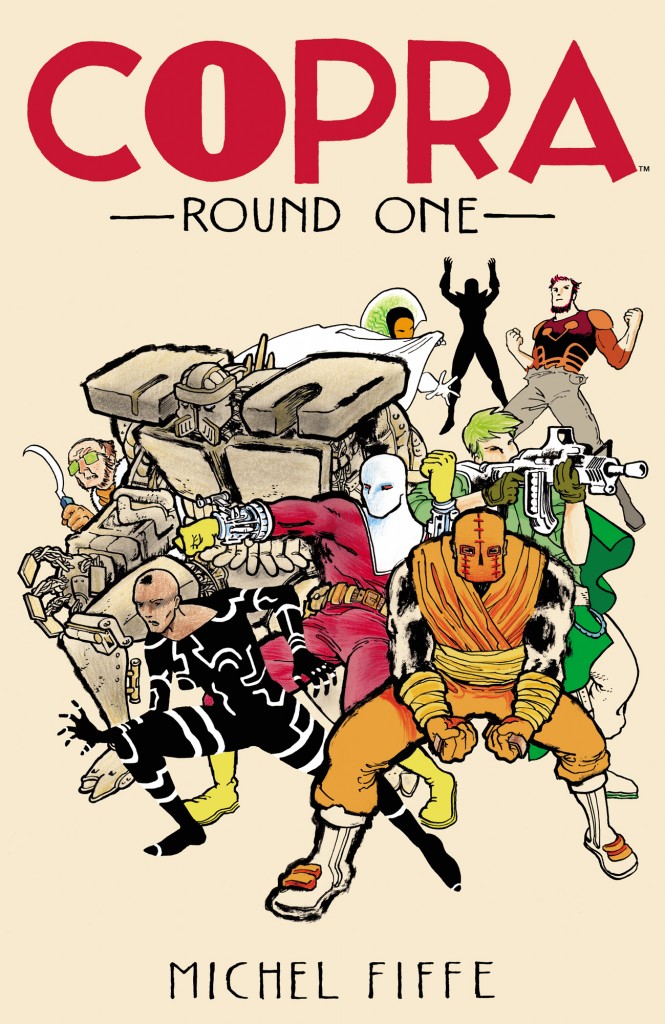
For me, COPRA is the one of the few superhero comics that really matter.
A few years ago, I was at a point where I had basically given up on everything produced within the arena of the “Big Two”. Sure, I enjoyed the occasional Grant Morrison comic when they would rear their head, but for the most part I had lost the exhilaration I used to get when I would read the adventures of my favorite costumed adventurers. Then, in the midst of a discussion of Jack Kirby and John Ostrander, a good friend floated along the idea that I would find great delight in reading the self-published wonder that is Michel Fiffe‘s riff on Ostrander’s biggest legacy work. What I found was a comic that embraced everything I loved about superheroes and the ideas of some of their most iconic creators, and then spun them off in wholly exciting and unpredictable directions. The jubilation that I feel whenever I crack open a new issue of COPRA is likely on par with what readers in the 70’s felt when a new Fourth World installment was released, or their counterparts in the 80’s when the aforementioned Suicide Squad and Watchmen were being unfurled upon an unsuspecting public.
COPRA reminds me of the actual potential of this side of the medium, and it’s a book that I wish everyone had their hands on. It is superhero comics at their absolute best.
While at HeroesCon, I had the opportunity to sit down with Fiffe to discuss what’s coming up in his lauded series along with other points of interest that encircle self-publishing and the day to day process of creating the issues in which he is responsible for every facet, including their mailing to subscribers. Here is Part 1 of our discussion:
When you conceived of COPRA, what was the impetus to say: “I’m going to self-publish this and do everything myself” vs. pitching it to a publisher like Image or Boom! or any other publisher that might have found a home for it?
I find the pitching process to be rather exhaustive and time consuming. I know it well, I’ve done it many times. It’s such a slow process getting a book green-lit and that’s not the nature of what I wanted to do with COPRA. It had to exist almost immediately. I don’t have a committee to answer to and that’s appealing to me. I’m not comfortable giving that power to whatever company.
And you did a lot of pitching before that you said?
Tons of pitching, tons of submissions, I’ve done pretty much everything I could think of to do to get in through the door. I’ve got some published works as a result, but nothing really satisfying, or that I really felt confident about. So, self-publishing, once I started doing that, that’s when I felt like I was creating comics on my own terms. COPRA is a natural extension of that, especially when I started giving myself a monthly schedule, mimicking the schedule of mainstream comics. For me, that’s the interesting dichotomy of it, where I’m harnessing this kind of “old-school” rigorous schedule to fit my independent needs.
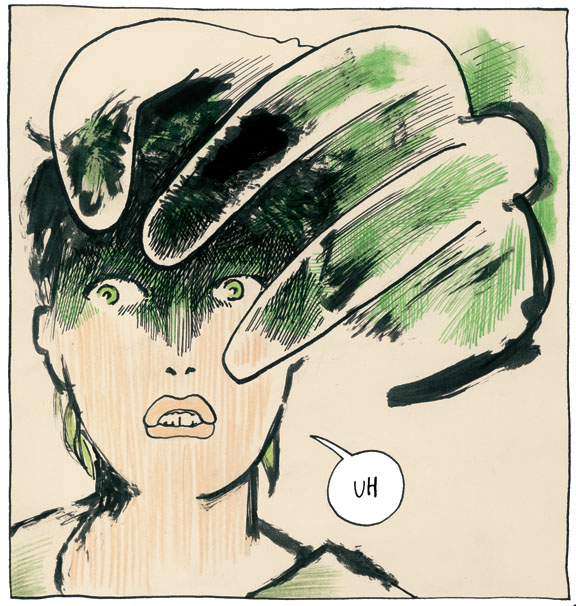 But are there significant challenges you find? I know there’s promotion that would be available in a big house publisher, like if you were working with Image there’d be press releases constantly. Is bandwidth an issue?
But are there significant challenges you find? I know there’s promotion that would be available in a big house publisher, like if you were working with Image there’d be press releases constantly. Is bandwidth an issue?
Well, motivation is always the biggest hurdle to overcome, especially given an unrelenting schedule. I have to wake up every day and treat this like a job, because it IS my job, it is my full-time job. I have to get it done somehow, I can’t wait for the muse to strike. I have to get an issue done a month, or as close as possible. But as far as challenges in not having the marketing muscle of other companies? I’d rather stand apart from the wall of noise. How many press releases does anyone really read, anyway?
Your comics, at least in their monthly form, are only available on your Etsy page and I noticed that you share that with your significant other, I think I saw some nice craft jewelry I think?
Yeah, Kat Roberts sells all kinds of stuff, zines, handmade purses, prints. I totally piggy-backed off her store on Etsy. That was a platform I was familiar with, so when I started publishing Zegas (Fiffe’s first self-published comic) I didn’t have a place to sell it from, except conventions and maybe the occasional store that would take a risk on it. Etsy allowed me to slowly build up my readership. By the time I got to COPRA, there was a significant amount of people that were interested in the stuff I did and that made it easier for me to move forward.
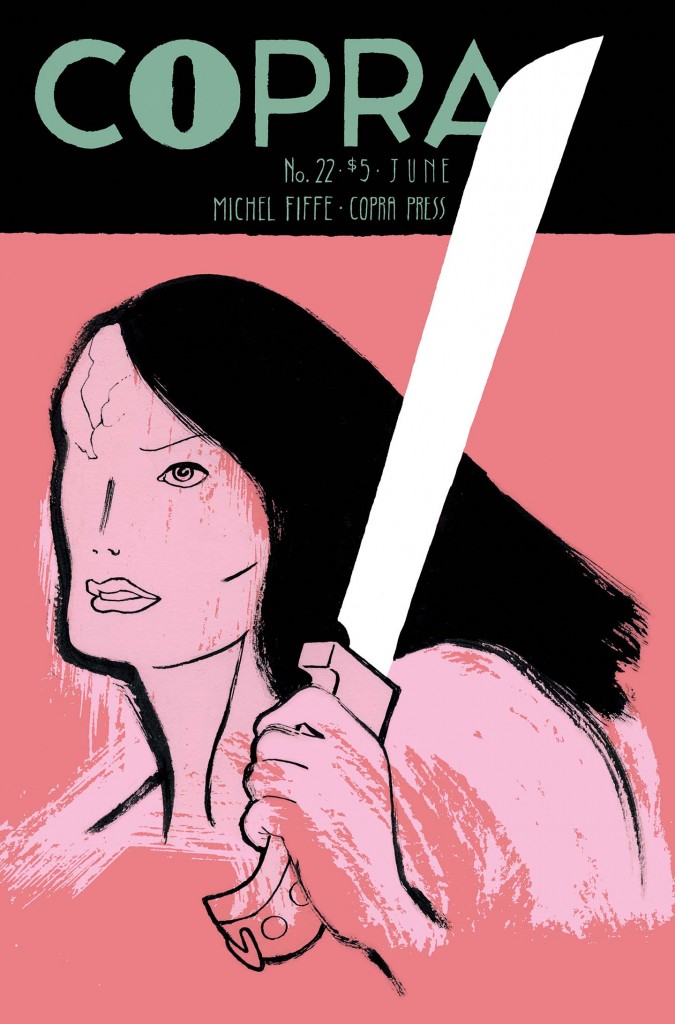 Let me turn to the actual creation process of an individual issue, say you’re sitting at your desk and working on Issue 22 right now?
Let me turn to the actual creation process of an individual issue, say you’re sitting at your desk and working on Issue 22 right now?
That’s the one that just came out.
Good, let’s use that one as an example, if you’re working on Issue 22, what is your step by step? Do you script first and then directly move into the illustration phase? Do you create thumbnails? How do you piece your typical issue together?
It always changes, but the constant thing is that I always map out the story, page by page, and then I script it loosely. Then I start penciling loosely with the first draft in mind. The real work portion of the process begins when I start refining the script while inking and sometimes hand lettering. That’s when it all starts coming together. But generally I have a very loose plan in mind per issue. It’s equal parts organic and strict. I just have to get a number of pages done every day, that’s basically my main objective.
What’s your average rate right now?
Comfortably, I’d say about two pages a day, complete with full color. And that may range, sometimes I may get three, sometimes just half of a page, it just depends. And then you also have to consider the managerial aspect of it after the book is done. I have to get it shipped out to readers and stores and that’s definitely a job in of itself.
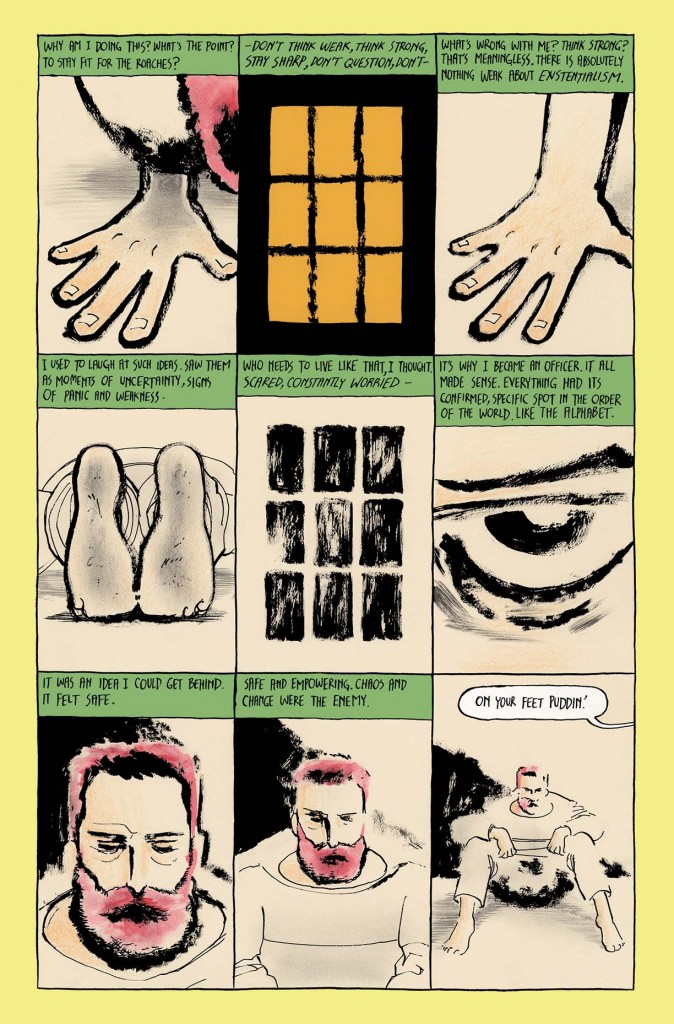
Was there ever a page or spread or a panel layout that was really hard to crack? Was there any particular example where you just said “oh my god, what am I doing with this thing?”
Every page is like that, but I try to make it work somehow. I have to bring that blank page to life somehow. But the trick is to not think about it too much, because if I over-think it – which is my natural inclination – it kills it. You can get caught up in that and then nothing exists, there are no results. I strive for perfection, but being my own worst critic, I have to be real careful to not crush my gut instinct.
You’re a real master of negative space, and I read an issue and think “damn, Fiffe really knows how to use that white”. I think that’s a rare talent, and I’m not trying to kiss ass, but when I read through recent issues it’s hard to not notice how much your craft continues to grow every single issue. I’m floored by the way you use this stuff.
Thanks, man!
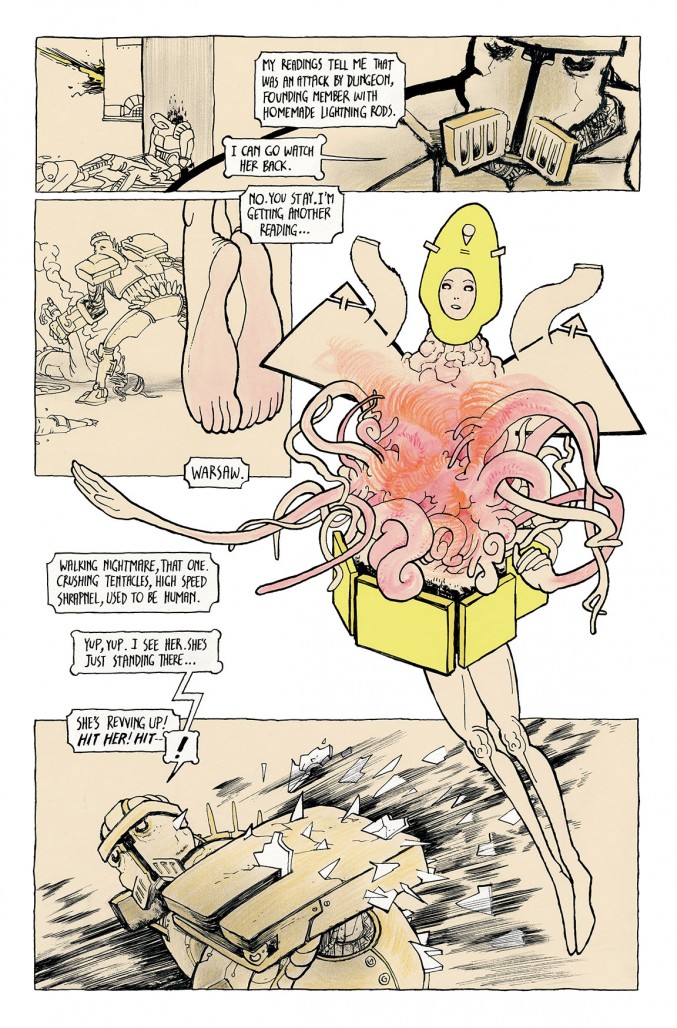 Back to COPRA‘s origins, if I may, when you began to pull together your characters designs and tried to piece together the different teams…and there’s a number of different teams now I guess, you’ve got COPRA, Asesinos…
Back to COPRA‘s origins, if I may, when you began to pull together your characters designs and tried to piece together the different teams…and there’s a number of different teams now I guess, you’ve got COPRA, Asesinos…
Right, it’s all splintered.
Yeah, I almost have a hard time keeping track.
I should map it out.
I would love that, if you would put a thing at the end of each issue with the full cast.
I’ve been thinking about that, actually.
That would be awesome, and I’ll take full credit if it happens. But when you were conceiving of your core cast, there are obviously analogous elements to Ostrander’s Suicide Squad.
Absolutely!
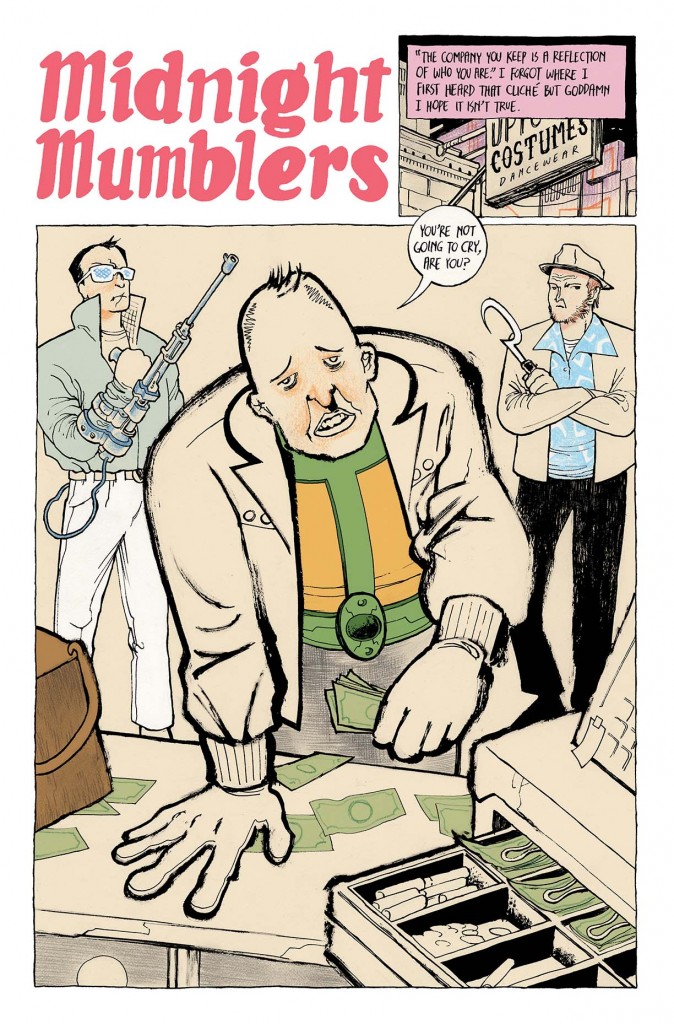 Did you ever find it was difficult to skirt the line between your own original ideas and those aforementioned analogous elements or did you just say, I’m going to use this as a starting point and go my own way?
Did you ever find it was difficult to skirt the line between your own original ideas and those aforementioned analogous elements or did you just say, I’m going to use this as a starting point and go my own way?
When I initially set out to do this comic, I put myself in the mindset of: “what if a publisher hired me to take over a title, and gave me complete freedom”, which would never happen in the current landscape. So using that fantasy to guide me, I took the Dirty Dozen-esque concept, which has been around for a while in many different forms, and I used it as a blueprint to work from. I wanted a world I could really sink my teeth into month in and month out. I wanted to make something that was serialized, that maximized the nature of the single issue, I wanted to build a place that made it easier for me to explore all my interests. The analogous aspect of it… I was reluctant at first, but I had forgotten that some of my favorite comics are analogous, too, some more blatant than the others.
Are there any examples you can cite? At least of the ones that fall favorably with you?
I mean, the Fantastic Four included a Kirby monster, Plastic Man, and Carl Burgos‘ creation as the Challengers of the Unknown… as a response to JLA. Watchmen, Marvelman, Supreme, everything Alan Moore does, basically. That’s no secret. So I moved forward citing those comics, using the current cultural momentum of irreverence to just do whatever I want. Plus, I figured no one’s going to be reading this anyway! We’re talking small press here, not many copies exist. It was liberating.
How far ahead did you map out your story?
Not that far, I did it issue by issue. I also wanted it to feel like a very immediate, raw, I wanted it to be as direct a thing as possible. So, it was really just one or two issues ahead. I mapped out twelve issues with super brief descriptions and that’s all I had to go on. I also wanted to make sure that I could fill twelve issues worth of stories. Luckily it worked out.
Look for Part 2 of our discussion on Sunday, when we discuss the possibility of digital distribution and what readers can expect in upcoming issues of COPRA.
You can purchase recent issues of COPRA at Michel Fiffe and Kat Roberts’ Etsy store, or you can order. While Bergen Street Press is currently sold out of both collected editions of the series, you can purchase the first collection at InStockTrades.

By: Vicki Salemi,
on 6/18/2015
Blog:
Galley Cat (Mediabistro)
(
Login to Add to MyJacketFlap)
JacketFlap tags:
Authors,
Publishing,
writing,
self-publishing,
People,
Martha Stewart,
cookbook,
Jodi Picoult,
Jane Green,
Kickstarter,
Good Taste,
Summer Secrets,
Add a tag
 It’s hard to believe that New York Times bestselling author Jane Green leveraged Kickstarter to fund her new cookbook, Good Taste. Although the campaign ends on July 14, devoted fans and celebrities like Martha Stewart and Jodi Picoult have supported her via social media and she easily surpassed her self-publishing goal of $45,000 within the first five days of her campaign. Drawing on stories from her life and the food that runs through them, the book combines recipes with photos and her witty storytelling.
It’s hard to believe that New York Times bestselling author Jane Green leveraged Kickstarter to fund her new cookbook, Good Taste. Although the campaign ends on July 14, devoted fans and celebrities like Martha Stewart and Jodi Picoult have supported her via social media and she easily surpassed her self-publishing goal of $45,000 within the first five days of her campaign. Drawing on stories from her life and the food that runs through them, the book combines recipes with photos and her witty storytelling.
We caught up with the versatile author to chat about venturing outside her comfort zone, leveraging new media to fund her project, and carving out time and space to write amidst her busy schedule.
GalleyCat: As a bestselling author, why did you decide to self-publish your cookbook?
Jane Green: I have been incredibly lucky with my novels but I had absolutely no idea if anyone would be interested in a cookbook. So I started to think about self-publishing.

I then realized that with Kickstarter, I [would] have to put this book together myself. So I did the test recipes and I found the photographer and an art director. I wanted my fingerprints on every page and they really are. Everything about this book has been chosen by me.
GalleyCat: It sounds like you really enjoyed this process. And as a graduate of the French Culinary Institute, was this a passion project? Were you thinking, “I love cooking so let me try this out?”
Green: Yes, 100 percent. I put recipes in a couple of my novels and they’ve always been well-received and this is a long-held dream of mine. I did sort of get into a conversation with my publisher a couple of times about how much I’d love it and they didn’t bite.
GalleyCat: How does it work exactly – will everyone who donated get a book?
Green: We funded in five days which I did not expect at all. That was kind of extraordinary but what it means is that we can now proceed with the printing. We’ll fulfill the books, we’ll be sending them out in October and so it’s the same as pre-ordering a novel in a bookstore. You can buy my book for $25 and you’ll get it in October.
This is a limited edition print run, it’ll be a collector’s edition. Because we’ve funded it, we’ll be able to publish all kinds of lovely things. I would love to do another cookbook, maybe a slightly different version. I may either do it myself or I may look for a publisher next time around.
GalleyCat: What are your thoughts on self-publishing? It sounds like you’re really enjoying this process and you’ve gone through the traditional route for so many years.
Green: It’s been a fascinating learning curve. What I’ve come to learn with self-publishing is that if you want to provide readers with something of equal quality, it requires the same amount of time and expense. I could have self-published and thrown something together and turned it up online but I didn’t want to do that; I wanted to create something that looked really beautiful and had lasting value.
GalleyCat: There can be a stigma with self-publishing. You’re an established author, you’re trying this route – has the stigma changed over the years and if so, how?
Green: I think that the stigma is very, very much in place and I think that the entire model of the publishing world has changed and doing what you’ve always done and expecting to get what you’ve always got no longer works.
GalleyCat: Let’s talk about social media because it seems like with the Kickstarter campaign and your Facebook and Twitter feeds, you’re really engaging with the reader. Has social media also changed the face of publishing?

Green: The whole thing now is about connection. Ten years ago, you wrote a book and you never expected to find out anything about the author. Now with social media, everyone wants that connection. I think our readers want to be invited into our lives and brought on the journey and be part of this whole process.
GalleyCat: Do you envision more e-books in the future or different ways of publishing houses getting involved beyond traditional books?
Green: My e-books sales have overtaken everything else, so I think all the marketing has become very much driven by the author now because of social media. The way that I run my Facebook and my Instagram [accounts], I can’t have somebody else doing that for me. It’s got to be my voice.
GalleyCat: What advice do you have for writers hoping to leap outside their comfort zone?
Green: When you stay stuck in the same groove, your creativity can dwindle. I definitely felt that I was on a bit of a treadmill and actually, stepping out of my comfort zone and using my creativity in a completely different way has just brought this incredible passion back into my life, which has spilled into every area. I’m energized in a way that I wasn’t before so if you’re a creative person, and we writers tend to be, the more cases we can express that creativity, the better. Actually, my next novel comes out on Tuesday, June 23 – Summer Secrets.

GalleyCat: How do you manage to carve out time to sit down and actually write when you’re so busy?
Green: Right now I’m busier than ever before and my whole writing routine has had to change because I have so many things going on. In the old days I’d write during the morning and I’d be done by lunchtime and be mom in the afternoon. I can’t do that now. Sometimes I can get away with a week here or there but now I have to go on these self-imposed writing retreats. Twice a year I’ll go off to a little inn in New Hampshire and I’ll just go and for five days I wouldn’t talk to anyone, I wouldn’t look at anyone, I’d just be in a room with my computer and I will write.
With the obvious caveats that this isn't scientific, different audiences, etc., here are the results! How are we planning to publish our work in progress? Let's find out.
After very similar results in 2013...
And
last year...
We have a bit of a change
this year! The number of people planning to self-publish and not even considering traditional has risen from 10% to 15%:
Though the people who are still planning to go traditional first is still roughly the same.
What do you make of these results? Will these approaches change over time or have people solidified into traditional and self-publishing camps?

Is self-publishing on the ascent? Do people still want the imprimatur of a publisher?
Let's find out. This is the third annual poll. How do you plan to publish your work in progress? Are you a die-hard traditional or self-publisher? Will you consider one or the other depending on circumstances?
Poll below. Please
click here if you are reading via e-mail or a feed reader.
Create your own user feedback survey Art: Richard March Hoe's printing press from History of the Processes of Manufacture by A.H. Jocelyn
 I began the Weekend Writer project a little over two years ago, because I was upset when a friend from high school was being pressured by a salesperson from some kind of pay-to-publish company. Last month in my local newspaper, I read about someone who had just published her first book. She had considered self-publishing, she said, but thought it was too expensive. Then she found a traditional publisher interested in her subject.
I began the Weekend Writer project a little over two years ago, because I was upset when a friend from high school was being pressured by a salesperson from some kind of pay-to-publish company. Last month in my local newspaper, I read about someone who had just published her first book. She had considered self-publishing, she said, but thought it was too expensive. Then she found a traditional publisher interested in her subject.
I had never heard of this publisher, but I'm not queen of the publishing world. I haven't heard of everybody. So I googled the name. Guess what? It was a pay-to-publish company. There's nothing wrong with that. Some self-published writers do use them. The issue here is that according to the interview this woman gave to the paper, she didn't know. She thought this company was a traditional publisher. A librarian friend who had seen the article said, "Isn't she going to get a bill at some point?"
What makes this story more disturbing is that when I googled the company name, the fourth site that came up was one at which writers who had paid the company to publish for them were reporting problems they'd had. We're talking a pay-to publish company with unhappy customers.
Don't Rush To Publish
You hear the expression "rush to publish" now in relation to self-publishing authors who want to get their book out right away. Speaking from experience, I can say that preparing a manuscript for publication can be nearly as much work as creating it in the first place. Writers
need to learn nearly as much about publishing these days as they need to learn about writing. The difference between traditional vs. self-publishing seems as if it should be the very minimum writers should know. However, I've heard of other authors being asked questions by self-publishing authors that indicated that those particular self-publishers didn't have even a basic understanding of what traditional publishers do.
Wouldn't you know it, I have covered this issue here before:
The Difference Between Traditional Publishing And Self-Publishing. If you are a new writer beginning to think about publishing, please read it.
But Let's Add To The Confusion
The line between traditional and self-publishing has become wobbly because some major traditional publishers have added self-publishing services, and many of them are all using the same company to provide those services. Check out
Author Solutions and Friends: The Inside Story by David Gaughran at
Let's Get Digital.
The bottom line here, folks, is that writers who plan/hope to publish need to educate themselves about publishing.
As a publisher, I subscribe to a lot of book publishing and marketing newsletters. Yesterday, I received the following email from two of those newsletters:
Ever wanted to write a children’s book?
If so, publishing your work as an e-book on Amazon’s Kindle platform is a great way to go – and now is a great time to get started.
The children's e-book market is up 475% this year alone, which makes it one of the fastest-growing book categories on Amazon.
Plus, once you know a simple formula, children’s books are one of the easiest types of books to write.
To discover how to get started writing and publishing your own children’s e-books, join Steve Harrison for a free webinar this Wednesday, April 1. (link redacted)
Steve will be interviewing an author who wrote a silly little 26-page Kindle children’s book in less than seven days, which, more than two years later, still produces more than $1,000 in royalties each month!
The idea that anyone can write a children's book using a "simple formula" is offensive and misleading. Writing a good children's book is not easy, it's
hard! It takes dedication, hard work and a willingness to educate yourself about children's writing.
A common misconception is that writing for children is easy, because the writing in children's books appears simple. But that simplicity is deceptive; it takes skill and experience to know how to write for children in a way that's appealing without talking down to them. Writing good children's books is harder than writing good adult books. That book your children beg you to read every night? It was probably the result of many rounds of edits trying to get exactly the right words and the right tone. Of course, good adult writers do the same thing, but they don't have to agonize over every word, every sentence the way children's writers do.
Simplicity is
hard! Theodor Geisel, better known as Dr. Seuss, is one of the most well-known and beloved children’s writers. The seemingly simple rhyming text of his stories has fooled many writers into thinking that it’s easy to write such books, but Geisel labored over each book, writing and rewriting, sometimes for a year or more.
Encouraging people to write a "silly little" children's book using a "simple formula" does no one a service, least of all the writers themselves. The marketing copy above leads people to believe that fame and riches are just around the corner and easy to achieve, when in reality nothing could be further from the truth. There are thousands of new children's books published every year, probably even more than that when you count all the self-published books. Many of those will languish in obscurity, many others will sell a decent number of copies and sit solidly midlist, and very few will sell a large number of copies. I personally know many, many children's authors, both traditionally published and self-published, and very few are getting rich. (Actually, I don't think any of my author friends are rich. If you are, let's talk!)
If you want to write a children's book, great! I admire anyone who pours their heart, soul, time, and effort into writing a book. But don't do it in expectation of making money. Yes, you might get lucky like the author mentioned in the ad above, but that's the exception, not the rule, and unless you are very, very lucky you won't achieve that. There is no magic formula that guarantees success - believe me, if there were, the big publishers would be using it! If you're going to write for children, do it for love, not for money. For most authors I know, the letters they receive from children mean much more than the royalty check. There's nothing wrong with wanting to make money from your writing, but if you go into it with that as your primary goal, there's a good chance that you're in for disappointment.
As a book blogger and
Cybils Awards organizer/judge, I'm active in the children's book blogging community. Self-published books have developed a bad reputation in the community, and many bloggers now have review policies that exclude self- or indie published books. For years, I've advocated for indie publishing among my peers. Authors self-publish for many reasons, and self-publishing by itself is not an indicator of the level of quality.
Self-publishing gives a voice to those who are disenfranchised by the traditional publishing industry. As one of the leaders of the Cybils Awards, I continually advocate to keep self-published books eligible and judged fairly and impartially. There are excellent self-published books, and a few have even been finalists or winners in the Cybils Awards.
But I sometimes feel that advocating for self-publishing is an uphill battle, when for every excellent book there are hundreds of others that are poorly done. People like Steve Harrison are making the situation worse by encouraging people to take the easy road, to produce more dreck that will further drag down the reputation of self-publishing. Not only that, but it misleads authors to believe that there is an easy road to success. There is no easy road that guarantees success! You might get lucky, but then, someone wins the Publishers Clearing House, too.
If you want to write a children's book, go for it! But rather than looking for easy formulas, take the time to learn what makes a good children's book. To start with, read a great many children's books. (If you have children, this isn't hard!) Read them critically, with an eye to what works well and what doesn't. (I've learned so much about children's books from nearly ten years of reviewing them for the blog, and nine years of being a Cybils judge). Read books about writing children's books. Take classes from reputable institutions or teachers. Join the
Society for Children's Book Writers and Illustrators (SCBWI) and your regional chapter of it. Attend writing conferences. Join or form a critique group. Check out any potential agents, publishers, promotional companies, contests, and more on the excellent
Preditors and Editors.One of my good friends,
Anne Boles Levy, has her first book coming out in August, a
YA fantasy published by independent publisher
Sky Pony Press. For Anne, it's been at least a fifteen year journey: writing, editing, revising, and submitting the book. Anne works regularly with a critique group that includes multiple award-winning authors; I believe that the group has been working together since before any of them were published. During that fifteen years, in addition to writing Anne also invested a lot of time into things that helped her to be known in the children's book community: blogging, attending conferences, and even founding a children's book award. None of that guarantees any good reviews, of course, but it does mean that Anne has a better than average chance of getting bloggers to take a look at it. I haven't yet seen the book (although I can't wait!) but I assume that all the work she put into writing it has paid off in the form of an excellent book.
Now, I'm not saying that everyone needs to invest fifteen years. That's a lot of time to wait to achieve your dreams. But I am saying that true success does not come overnight in most cases, and if you want to succeed, you need dedication, perseverance, hard work, and a willingness to learn.
Don’t give in to the siren call of get-rich-quick schemes. Instead, invest your time and money in learning the craft and trade of children’s writing and publishing.
To self-publish or traditionally publish. That is the question.
Whether tis nobler in the mind to suffer the slings and arrows of agents and publishers or to take arms against a sea of books on Amazon, and by being among them, rise above? To die, to sleep (oh wait you won't), to sleep perchance to dream of fame and riches... aye there's the rub.
Ahem. Sorry.
So. You have yourself a book. Should you just go ahead and self-publish and see how it does? Should you try your luck with agents and publishers? Should you try agents and publishers first and then self-publish if that doesn't work?
Having traditionally published the
Jacob Wonderbar series and self-published
How to Write a Novel, I've seen both sides of the publishing world.
Which way should you go? Here are seven questions to ask yourself:
1) Is your book a niche/passion project or does it have broad, national appeal?In order to attract a traditional publisher, especially one of the major ones, you're going to need to have a book that fits squarely into an established genre, is of
appropriate length, and has mass commercial appeal.
Be honest with yourself. Is your book something that has broad, national appeal or is a niche? Is it a potential bestseller or something you just wrote to, say, have your family history recorded for posterity?
If it's hyper-specialized you might want to either try for a similarly specialized publisher, or just go ahead and self-publish. And if it's a passion project without commercial potential you're probably best-served going straight to self-publishing.
2) How much control do you want over the publishing process?If you go the traditional route, you'll have an agent who will likely want you to edit your work before submission. You will (hopefully) have a publisher who will want you to revise your work. You won't have approval over your cover, and you'll probably only have mutual consent on your book title, meaning if your publisher doesn't like it you'll have to think of a new one that you both can agree upon. You'll probably have limited control over how and where your book is marketed.
Traditional publishing is a group process and you absolutely cede some control over your book. This can be a good thing, chances are you're dealing with experienced people within the publishing industry who are experts in their fields, but you may be frustrated at times with decisions you don't agree with.
Meanwhile, with self-publishing, everything is up to you. Edits, cover, title, fonts, marketing, whether or not you want to include that stream of conscious sequence about the philosophical implications of of cotton candy... all your choice.
3) How much does the validation of traditional publishing matter to you?The stigma surrounding self-publishing has largely dissipated, but it's not gone entirely.
And there's still something gratifying about doing something as hugely difficult as making it through the traditional publishing process, having your work validated by professionals, and being paid for your efforts. The names Penguin Random House, HarperCollins, Simon & Schuster... they still matter to many people.
Success is success, and in the end it's the readers who are the ultimate validators. Do you want the validation that comes with traditional publishing? Or are you cool going straight to readers?
4) How important is it for your book to be in bookstores and libraries?While you might be able to strike up some individual relationships with local bookstores and libraries as a self-published author, the surest route to bookstores and libraries is through traditional publishers, who have wide distribution.
Do you care about being in bookstores? Are you writing in a genre, like books for children, where libraries are super-important? If so, you might want to pursue traditional publication.
5) How capable are you at self-promotion?There's no guarantee that a publisher is going to adequately promote your book, but they'll at least give you a bit of a boost at bare minimum.
If you self-publish, you're entirely on your own. You don't necessarily have to be a social media maven or a celebrity in order to give your book the boost necessary to generate crucial word of mouth, but
you're going to have to do something.
6) Can you afford to invest money in your book?Say what you will about traditional publishing, but one great thing about it is that it is not very cost prohibitive. You might incur some postage sending your manuscript around or if you
choose to pay an editor before pursuing publication, but agents don't charge you until they get commission for selling your book, and publishers pay
you.
Self-publishing similarly doesn't have to be hugely cost-prohibitive, but there are a lot of tasks involved in self-publishing, such as generating a cover, editing, copyediting, formatting, self-promotion, that you're either going to have to spend the time to do yourself or pay someone to do for you.
Depending on how much time you have to spend and your level of expertise, you may end up spending a thousand dollars or two to effectively self-publish. Can you afford that? (And you shouldn't necessarily assume you're going to get it back).
7) How patient are you?Choosing traditional or self-publishing isn't necessarily an either/or decision. You can absolutely decide to pursue traditional publishing first and fall back on self-publishing if you so desire.
But even in the best case scenario, traditional publishing can take forever. It can take a year or more to query agents, and then a year or more to find an editor when you're on submission to publishers, and then even if you get a book deal it can be a year or two after that before your book comes out. It can very easily add up to two or three years or more
after you finish your manuscript.
Meanwhile, when I finished
How to Write a Novel, it was up for sale a few days later. Self-publishing is practically instantaneous.
Are you the patient type? Do you want to cut to the chase? That can perhaps be the most important factor of all.
How did you decide whether to pursue traditional publishing or self-publishing? Did I miss anything?
Art: Le tour de la France par deux enfants by G. Bruno
Warren Adler, author of the bestselling novel and film The War of the Roses, has been self-publishing through his imprint Stonehouse Productions for years and has found it quite successful.
He is currently developing the Hollywood sequel to The War of the Roses, The War of the Roses: The Children, along with other projects including: Capitol Crimes, a television series based on Adler’s Fiona Fitzgerald mystery novels, as well as a feature film based on Adler and James Humes’ WWII thriller, Target Churchill, in association with Myles Nestel and Lisa Wilson of The Solution Entertainment Group.
GalleyCat caught up with Adler to discuss how publishing has been evolving and where it is going.
GC: How has self-publishing evolved?
WA: The Internet has opened up an arena in which people’s latent desire to be noticed, and to communicate their thoughts, opinions and alleged talents to others, has spawned an explosion of creative expression of epic proportions.
Publishing technology led by Amazon has blasted open those gates, and any writer who can put words on a screen can, with little effort and expense, offer a book for publication, joining an endless cyber shelf along with every popular and classical author on the planet.
Some few in various categories have found a market for their efforts. The overwhelming majority has not, except for sales to devoted friends and relatives. For some, this is satisfaction enough. For those who have fantasized of achieving instant fame and fortune, it has been an exercise in disappointment and frustration. Nevertheless, like the impossible odds of winning the lottery, a very few have exceeded beyond their wildest dreams, and have encouraged more and more to enter the fray.
GC: Is the market-oversaturated?
WA: As long as there are no limits on the offerings, and there is infinite cyberspace to accommodate anyone who chooses to create a book, the market will expand exponentially. Indeed, no eBook will ever go out of print and the numbers will continue upward.
Amazon is clearly able to profitably absorb the flow, and as others like Apple, Kobo, and perhaps Nook expand their capacity, the market will proliferate endlessly. Screening attempts, meaning subjectively picking the wheat from the chaff, which was once exclusively the work of selected print publications and reviewers is now in the hands of a vast array of self-appointed recommenders and critics who have collectively become \"the screeners.\" They offer milliseconds of opinion plucked from the infinite swamp of review offerings.
GC: What do you think of Amazon reviews?
WA: There is the phenomenon of the starred review, which has become, despite being dubious, largely an unreliable and non-transparent source, a kind of pop standard critique of a book’s worth. I often wonder how the Bible might score on this standard. \"A bit wordy, too many names and undefined characters and plot lines.\" One star.
The opposite of infinite is finite. Need I discuss the fact that the readers of books are finite and, by most accounts, shrinking.
GC: How can authors get noticed in this landscape?
WA: A cottage industry has grown up around the premise of authors getting noticed, all of which advocate the same basic ideas. Engage with potential readers, blog frequently, create a fan base, stay in touch, seek speaking engagements, attempt to get into readers clubs, send press releases, engage professionals for PR and advertising, try for television and radio interviews, send postcards, do videos and podcasts, find creative ways to keep your name out there. These ideas work for notoriety, although sales are never guaranteed.
Of course, for many the grand prize is to get your book adapted for television and film, the longest shot of all. If the adaptation is an enduring hit, then it will be very helpful to book sales. If it is a flop, it won’t be much help. Besides, if you’re lucky enough to get a production, the chances are that it will happen long after your book is launched – this has certainly been my own experience.
The secret to all this advice is consistency and repetition, requiring a serious commitment of time, effort, and money.
GC: What do you expect in the future of book publishing?
WA: With shelf space diminishing in brick and mortar stores, and infinite cyber book \"shelves\" proliferating with endless books in all categories, a number of scenarios suggest themselves:
1. Random House or a competing company, in self-defense, could buy up Barnes and Noble’s stores and other chains still existent around the world and set up their own combination of brick and mortar and cyber stores.
2. Amazon could buy Barnes and Noble to complement its already formidable hold on the market.
3. Amazon could set up its own bricks-and-mortar chains and create some creative ways to use its POD operation in some shelving mechanism yet to be developed.
4. Authors with some recognition and respectable output in the past and with some subjective compatibility will form their own publishing companies as individuals or collectives and pool their resources in an effort to market their work, not only in books, but in all media worldwide.
Authors are particularly at risk in this new environment and, as one of that tough and irascible breed, I wish I could offer a comforting look into the future. Writing is our calling. No matter how conditions change in the marketplace we will soldier on no matter what.
When I set out on this new publishing adventure, I didn't realize it was going to be such a different adventure. Putting together and publishing an illustrated children's story is a very different experience than publishing a coming-of-age novel. In fact, one has very little to do with the other. Let me count the ways:
- With a novel, you paint a picture with words. Lots of words. With an illustrated children's book, you paint a picture with words, but it also needs real pictures. And because I am by no means an artist, I can only hope that the illustrator sees what I see (or sees better than I see). Finding the right artist is of the utmost importance. And because the story is under 600 words instead of 90,000 words, every word is heavily weighted. Add to this the fact that the text in this case rhymes… and that some words have no rhyming friends, this is HARD! And a great challenge.
- There are lots of options for self-publishing a novel. Createspace. Lulu. Ingram Sparks. The list goes on. When it comes to self-publishing a full-cover book, the list is significantly shorter: Ingram Sparks. That's one company. One option, at least in the POD (print-on-demand) market. Because I live in Germany, it's really my only option. I can't order 5,000 copies of the book from an offset printer and store them in my garage and offer people autographed copies and send them out when they're ordered and go around to bookstores begging them to carry my book. No, I will have to rely on the worldwide distribution and shipping options offered by Ingram Sparks. Captive customer I am.
- Ingram Sparks is significantly less user-friendly than Createspace, and it's significantly more complicated to get an illustrated book print ready. The IS manual for preparing the PDFs is overwhelming. Welcome, Elance. It is there that I hope to find someone who has done this before and who will do this for me for a reasonable price. If they manage the first version (English) correctly, they will get the job for all the other versions. Incentive for them to do a great job, I hope! But I'm really nervous about this part.
- Ingram Sparks is slower than Createspace. I will actually have to wait a few weeks for the print version once they have everything. Which is still significantly less time than I would have to wait if this were being published by a traditional publisher.
- It costs a heck of a lot more to self-publish a full-color book. Thus the Kickstarter campaign.
- If this book is going to be available for tablets, I'll also need someone to convert it to ePub. Some things are really beyond my capabilities.
- I'm used to doing things myself. Instead of being a one-woman show, from the writing to the cover art to the formatting and technical details, I now need a whole team:
- Me, writer and project manager
- Solongo Drini, illustrator
- Translators (who knows how many there will be?)
- Layout person from Elance
- And let's not forget my editor-support team-inspiration, my husband :) He was there for me with the novel, too, so I guess I was actually not a one-woman show, but a one-couple show. Because yeah, I quilled the cover, but he took the pictures, fixed the lighting, moved things around… basically made it all look good. Because people do judge a book by its cover.
So…. Things slowed down in the writing department. I did write a second novel, and have been trying to shop it to agents. There has been strong interest, but still no bite. I haven't given up, but I'm taking a break. The constant rejections are tough to take.
Quite a few years ago, I wrote a children's book about the winter solstice. I really liked the book - it also had some strong interest when I shopped it to agents, but again, no bite. It's in prose, which is a little bit of a hard sell right now. One publisher I applied to directly loved it, but they were worried that since it took place in Central Asia, they weren't going to be able to find an illustrator who would make accurate depictions of the people and environment. I so went into Internetland and found one. And ever since then, I cannot imagine this story without envisioning her artwork.
But it costs a lot of money to pay an illustrator.
But I couldn't stop thinking about it.
When I ran the idea past Levent, my sounding board and best advisor, he suggested that I run a Kickstarter campaign to fund self publication and illustrations. Best. Idea. Ever. A Kickstarter campaign will both help me gather some financial support and help me publicize the book. Kickstarter takes 8-10% of the money you gather, but in return you get great publicity and help in small amounts from friends, family, and also strangers. Above a certain donation amount, funders will also receive a copy of the book (or two, or three, depending on how much they donate).
After this brilliant idea was planted in my head, I had to ask the illustrator if she'd be interested in working with me on this. She had a baby a couple of months ago, so I anticipated rejection and also put up a job offer in Elance to see what other illustrators were out there and what they would charge. There are some awesome - and awful - illustrators out there. BUT my first choice illustrator (I won't mention her name yet) accepted the project, so it's a go!!!
I'm working on final revisions of the text, and we're working together to design the cover so that we can begin the campaign.
I plan to get the book reviewed and also promoted by Kirkus this time around, and really do a promotion blitz. I'll also apply for prizes and awards. There are so many out there, and I have to believe that this book will stand a chance. Believe it or not, lots of awards go unawarded because they don't get applications.
This book is not going to make me rich. Rich authors are few and far between (much to Levent's chagrin). But I really do believe that my story combined with the amazing illustrations (they will be amazing, trust me) will be read to children at bedtime in the winter, when the days are dark and short, and the nights are darker and long. I'll keep you all posted on the progress!
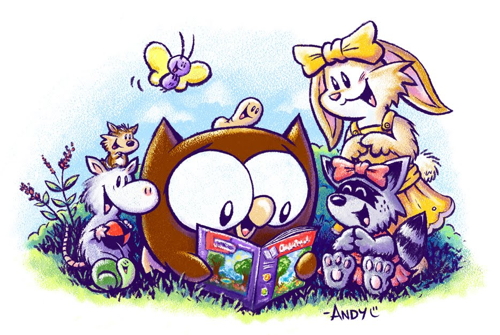
When IDW acquired Top Shelf a few weeks ago, there was much talk about creators like Alan Moore staying around, but Top Shelf’s Chris Staros made it clear that he had discussed the move in advance with his top creators.
One much liked book that Top Shelf published for about a decade is Andy Runton’s Owly series, a steady seller that helped establish kids content in the indy world long before it was fashionable. However, as noted by Johanna Draper Carlson, Runton tweeted that he would be self-publishing Owly going forward.
I reached out to Runton for more information and he explained that this had aboslutely nothing to do with the IDW deal. His contract with Top Shelf actually ran out last year, and he had made plans to self publisher starting then. “I’ve been thinking about self publishing for a long time and have gotten some great advice from Terry and Robyn Moore,” he told The Beat. However, a series of personal setbacks put this on hold for all of 2014, and he has no firm publishing lans yet. Hopefully, we’ll see Owly coming back in 2015, and Runton back on top form.
So this week I sent out six new agent queries. I'll do more next week; it takes a lot of time to explore agents and pick those who you think will connect with your writing. I feel good about it, even though statistically speaking I likely won't end up with any of them as my agent. I am pretty sure I'm not the only one who gets frustrated by this merry-go-round of submissions and rejections. Why do we keep doing it?
I'll tell you why I keep doing it. I am not interested in self publishing. I have nothing against it, per se. It gains more and more credibility every year as a viable path. But I want to write. I don't want to negotiate contracts, pay for my books to be printed, market all by myself. I just want to write my books. So I keep doing it. (I will say that most of the self-pubbed books I've read have not been of the same caliber as traditionally pubbed books. This isn't to say it's not possible, but traditional publishers have teams of people who work on your book. It's bound to improve the quality of the thing. I should also add that I edit for self-publishing authors, and I think those who hire an editor end up with a much better book.)
I have several friends who were almost at the end of their proverbial ropes when they finally signed with an agent and sold one or more books to traditional publishers. Their stories lift my spirits when I want to give up.
Here are a few of things I've learned over my many long years of writing, submitting, being rejected, and trying again.
1. If the same work keeps getting rejected, maybe it's time to set it aside and work on something new. I know for a fact that each book I write is better than the last. And every time, I think this one is it, until it's not. Each one teaches me something I didn't understand before. So don't put all your eggs in that one basket.
2. I am confident that I am a good writer. Maybe even a great writer. I know this because I go to a lot of workshops, conferences, retreats, and critique groups with professionals, and they tell me this. Also because I've been practicing for a very long time. Also because I read by the ton, and I know what's out there. Also, because I have no ego left, so I can assess my own writing in a fairly unbiased way.
3. It's a good thing that some of the agents and editors I've submitted to have rejected me. As mentioned, I been in this rodeo quite a long time, and I've seen the big stall that can happen to a writer with an agent who isn't right for them. Inevitably, that partnership ends, and one has to start all over. As I have gotten to know some of the agents I once thought would be perfect for me, I cry happy tears that they didn't sign me.
4. Agents are just people. Very fallible people. Very nice people. Professional people. But there is nothing to be afraid of. I have given up the role of sweet little author who needs the help of an agent (if that ever was me), and I have started being completely myself when I query and submit. I tell people straight out what I want, what I'm willing to do, and what my vision for a particular book is. I am too old to tiptoe around, hoping my good behavior will get me in the door. You know that saying about well behaved women rarely making history? That.
5. Even when nothing happens, something is happening. I spent the last year hoping to nail down a particular agent. She asked for fulls of two manuscripts, read them, sent back copious editorial notes. I spent two months revising one manuscript per her notes, resubmitted at her request, and waited. For six months. Nothing. All my writing friends said to move on, which I am doing. But that was a good experience, because it gave me more confidence, revision notes to work with, and some good revisions came out of it.
6. Never, ever sit around and wait for that reply. Be working on new things and revising old things and researching and everything else. It gives me so much energy to be working on the next, new, shiny manuscript that I can forget there is ever one making the rounds out there. It keeps me from obsessing or worrying. It keeps me moving forward and writing better books.
I wish us all the best luck this year in achieving our writing and publishing dreams.
MERRY CHRISTMAS!
Join Leslie Helakoski and Darcy Pattison in Honesdale PA for a spring workshop, April 23-26, 2015. It's a great Christmas present to yourself or a writer friend! Full info
here.
COMMENTS FROM THE 2014 WORKSHOP:
- "This conference was great! A perfect mix of learning and practicing our craft."�Peggy Campbell-Rush, 2014 attendee, Washington, NJ
- "Darcy and Leslie were extremely accessible for advice, critique and casual conversation."�Perri Hogan, 2014 attendee, Syracuse,NY
About eighteen months ago, my writing career pivoted: I decided to commit to self-publishing my work. I’ve not talked about it much because I’ve been so busy being an author and publisher, but I’m going to take time to reflect on the experience and look toward the future.
WHY INDIE PUBLISH?
There are many reasons why I decided to go this direction but in the end, it’s a question of creativity. For many years, I’ve felt hobbled by the traditional publishing world because I can and do write a lot. Independent publishing offered me a chance to write and publish many titles in a short time period. It’s also offered me the possibility of creating a steady monthly income.
Setting Up an Indie Publishing Company
When I committed to funneling all of my work though my own publishing company, I had to make business choices.
What type of company? Self-proprietorship, C or S Corporation. Name of company?
Buy a domain, set up a website, open a business bank account, get a local business license, get a sales tax ID, etc. Don’t discount the business side of indie publishing; but don’t fear it, either. There’s lots of help for these business decisions. In the end, I set up MimsHouse.com — go take a look; I’m excited about this opportunity.
Then, to work! The first eighteen months have been about three things: production, distribution and accounting. I’m assuming that writing is always happening in the background, for it is, in fact, the foundation of everything else.
Accounting. I’m using QuickBooks and this is the hardest thing I do. I just keep plugging away at learning good business accounting and long for the day when I can afford an accountant.
Production. The first question to answer is formats. I decided to try every format possible: paperback, hardcover, eBooks. That sounds easy enough. Ha! It’s complicated. After 18 months, here’s my current configuration.
- Createspace.com paperback in two versions. One version is with my own ISBN and is for general distribution; a second version is with a Createspace ISBN and I only enable it for distribution to Baker and Taylor.
- LightningSource.com (NOT Lightning Spark which is the only section of the company currently open to newcomvers). I currently do paperback and hardcover books here.
- eBooks. OK, this is where it gets tricky because each platform wants a version for their proprietary platforms. Currently, you’ll find my ebooks on Kindle, iBook, Nook, Kobo and various educational publisher’s platforms.
File production for the print and ebooks varies depending on the type of book. Also, technology changes every six months or so, which means that each time I come back to produce files, I have to reevaluate previous production methods to see if they are still the best, are compatible with the current ebook and print standards, and are the most cost-effective.
- Novels that are mostly text-based or short chapter books with b/w drawings. I create the book in MSWord, making sure to be very strict on the style sheets. Word exports to print quality Adobe pdfs for printing on paper. I use Jutoh to convert these to ebooks.
- Color picture books are laid out in Adobe InDesign, which a access via a $20/month subscription; the October, 2014 update to InDesign has made export to ebooks simple. I mean VERY simple. I tried the mid-year release of Kindle Kid’s Book Creator program and found it easy to use; however, there are two main problems with it. First, it only creates the .mobi files for Kindle, and I still had to create epub files for other distributors; second, it creates a bloated file which means you have huge download costs from Kindle. At 70% royalty, they charge the publisher $0.15/MB download fee, which amounts to a “printing cost.” A file created with the Kindle Kid’s Book Creator program is easily 6-8 MB, or $0.90-$1.20 per download. You have two choices: charge a lot for the book or drop to the 35% royalty which doesn’t charge a download delivery fee.
Examples:
$2.99 at 70% payment, 8MB file
$2.99 x 70% = $2.093 – $1.20 delivery fee = $0.893/book
$2.99 at 35% payment
$2.99 x 35% = $1.0465/book (NO delivery fees at this rate)
InDesign, on the other hand, takes the same book and creates files of 3-4MB.
$2.99 at 70%, 4MB file
$2.99 x 70% = $2.093 – $0.60 delivery fee = $1.493/book
My choices, then are to profit $0.89, $1.05, or $1.49 for each eBook priced at $2.99.
InDesign’s smaller file sizes mean money in my pocket, AND flexibility in what I charge. I could drop prices to $1.99 for a sale and still make a profit of $0.79/book; it’s my choice.
Math. It runs the business and it affects production methods!
Illustrations. Another problem of production has been obtaining illustrations for my color picture books. Fortunately, the first couple books were done in a joint business arrangement with Kitty Harvill. Since then, I’ve had to find funds to pay illustrators. Behance.net has been a great place to find new illustrators. That is Adobe’s social media site for artists, where they post their portfolios. Ewa O’Neill’s debut books will be out in February; and Rich Davis, a local longtime friend and amazing illustrator, struck a deal for b/w line drawings for my short chapter series. So, I drew from friendships and from an artist’s social media site to find quality, exciting art. This has been one of the most creative and fun parts of the process, to work with some great talents to produce amazing books. I’ve learned a lot about being an art director and working with artists—it’s just fun.
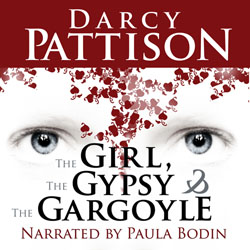
AudioBooks. Amazon’s ACX program is in its infancy, but it offers authors an entre into the audiobook world. By hooking you up with a group of narrators who will audition for your book, you have control of the process and can end up with some exiting audio books. It’s hard to say which is my favorites: I love the actress Paula Bodin’s reading of my novel, The Girl, the Gypsy, and the Gargoyle; she truly brings the story to life. Monica Clark-Robinson brings her acting skills to the production of Saucy and Bubba, which is especially exciting because she’s a local actress and author. Josiah Bildner knows how to crack a joke! His narration of the Aliens Inc, Series, Book 1: Kell, the Alien shows his genius in timing of comedy.
Distribution. The third piece of the puzzle for the last eighteen months has been distribution. This means I’ve had to think hard about where my books might sell. Who is my customer? Where does that customer already buy books? What price points do they want/need/like?
Because I mostly write children’s novels and picture books, eBooks haven’t been as big a factor (though, I think that is changing in interesting ways). My customers are parents, teachers, and school librarians. Teachers and school librarians buy from education distributors, rather than from the trade markets. They can and they do buy from Amazon, B&N and other online places, of course. But the bulk of their budget is spent at places that cater to their needs.
I’ve picked up distribution from Follett School Solutions, Mackin, Permabound, and Child’s Plus. The first three also have emerging eBook platforms which I think will become increasingly important. It means more production work because they want yet another format! It’s just a different type of pdf to export, but it means another step.
Pricing. Also, this sales channel brings some challenges in pricing. 1-to-1 pricing means a school building buys one ebook and has the rights to put it on one device only. 1-to-many pricing means a school building buy one book and has the right to put it on an unlimited number of devices.
Naturally, educators prefer the 1-to-many pricing structure; but this is so new that there’s no best-practices standards on how much extra to charge. You don’t want to leave money on the table; however, you want the pricing to be attractive.
I’m told that some publishers are asking 2x, 5x or even 15x the 1-to-1 price. But no one really knows what price structure will work. For a Newbery Award winning book, you could likely charge 20x—which in effect gives a full class set to a school building—and educators will gladly pay it. In other words, the popularity of a title, the likelihood of its use as a class set, and factors such as this should determine the 1-to-many pricing.
Also interesting is that the school pricing tends to stay at or near the suggested retail pricing, with few discounts. Translation: you’ll make more per book.
The first eighteen months have been busy. I’ve learned to pace the writing with production and marketing efforts. I’ve set up production protocols that allow me to be efficient in putting the books into multiple markets. And I’ve picked up distribution from education publishers, while also making sure I cover the digital and print distribution channels.
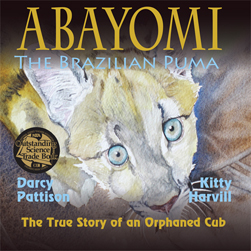
2015 NSTA Outstanding Science Trade Book.
Because I come from the traditionally published world, I also decided early on that I would submit books for awards. That meant Mims House joined the Children’s Book Council, which gave me access to a variety of programs. In November, 2014, I learned that my nonfiction picture book,
Abayomi, the Brazilian Puma: The True Story of an Orphaned Cub was named a
2015 NSTA Outstanding Science Trade Book.
I was ready. I already had the book in distribution to all major channels, including education distributors. Immediately, I sent press releases to those channels—and sales have picked up. I expect that early next year will bring even more sales for this award-winning book.
Someone once said that marketing means you produce demand for your books. You do that first and foremost by writing and publishing a great book. After that, you have to break through the noise and get noticed; and then you need to keep the book in the foremost of your customer’s mind for as long as possible.
Marketing is what I’ll focus on for the next year. I’m trying everything from online ads to awards programs to social media blasts. Ask me at the end of 2015 what I’ve learned about marketing.
WHAT I’VE LEARNED IN THE LAST 18 MONTHS
- Indie publishing is refreshingly creative. It’s not about control for me, though, I hear that sentiment often. Instead, it’s about creativity. It’s opened creative channels for me in the production of the books; and it will continue to challenge my creativity in marketing. Both of those have challenged the foundation of selecting stories to write: I now start out with a stronger consideration of audience. I like how the creativity builds as I engage in more aspects of the book production, distribution and marketing. Working with creative artists and audio narrators is inspirational, too.
- Patience is crucial. I went into this with a long-term perspective. As an indie publisher, I am a small business owner. In the U.S., most small businesses fail in the first year; most don’t make a profit until their fifth year. From day one, I had books in distribution so I’ve made money. I sold a website domain for a nice profit and that added to my reserves. Financially, the cost to enter this business is extremely low, and it’s been easy to build up the income levels.
Still, patience is crucial because as an indie publisher I can’t afford the book launch splash; instead, I must rely on a slow growth of a title as word-of-mouth grows. You hear stories of fantastic sales of ebooks—but that’s rarer for children’s books. It’s just a different market, and I constantly remind myself that I am building for a future so I don’t need to be impatient.
- Try everything. Test everything. This year, I’ve said YES to everything I could. I’m testing to see where and how I can reach an audience that likes and will buy my work. I’ve done Facebook ads, GoogleAdwords, displayed at various local and regional events, set up a sales channel on my own website, and much more. I don’t have lots of capital, so I’m careful in choosing where to put effort; but my attitude is to try something new if at all possible. Take risks.
- Write. Through all of this, the writing remains. It’s the foundation for everything else.
CHALLENGES AND PREDICTIONS FOR 2015: Indie Books for Children
- Pay attention to the education market. The education market for ebooks is poised to explode; I hear of more and more schools going 1-1, or one ipad/tablet for each child. I think the education distributors such as Follett, MackinVIA, and Permabound are going to be players, but also look for the sleeping giant, Apple, to come on strong. Since the iOS8 update this fall included iBooks as a native app, I’m moving many more books on Apple than on Kindle. It’s going to be a wild ride as companies jockey for position and as the pricing structures shake out. I’m working hard to put more books on the iBook platform; see my author page on iBooks.
- Hard work. Indie publishing will continue to expand, but I think the boom of 2008-2014 has played out. Now, you’ll have to dig in and work harder to get noticed. It’s only limited by your imagination, your work ethic and a bit of luck. And beware of rip-offs who promise to make your book a best seller!
- Change is inevitable; be ready to adapt or pivot. 2014 saw a rise in the subscription model of selling books and a host of startups that touted one way or another of promoting, marketing and selling books. Inevitably, most of these will fail; but no one knows which will fail and which will succeed. You’ll have to pay attention to the unfolding events and take advantage of sales opportunities as they arise.
- Global media company. One interesting idea is to consider myself a global media company. This year, I did an online video course of 30 Days to a Stronger Novel to accompany a book’s launch. And illustrator Kitty Harvill, who lives in Brazil half the year, is working on a Portuguese translation of Abayomi, the Brazilian Puma. (If it goes through that will be my 9th language! English, Spanish, Swedish, Danish, Norwegian, Arabic, German and Taiwanese Chinese.) Will the digital world allow for an expansion into other media and a global market? Of course. It’s a question of how to approach it. It’s one area I’ll be paying attention to in 2015, whether or not I actually make direct moves on either front. I’ll be reading anything possible about the expanding German market, and perhaps experiment (Try anything!) with more video or audio.
- One key to success: own your own audience. You’ll see less emphasis on social media activity such as growing a Facebook Fan page. As the major social media companies work to expand income, they continually change the rules. In essence, they own your audience, not you. Instead, smart authors will build their own mailing lists of loyal fans who want to hear about new releases. Get the Fiction Notes newsletter and the MimsHouse newsletter here.
In the end, all of us in publishing are asking one question: How can I put more of my books into the hands of the right audience in the most profitable manner? We’re answering that in a myriad of ways. How do you answer that question?

View Next 25 Posts





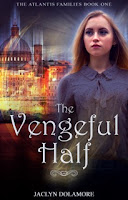





























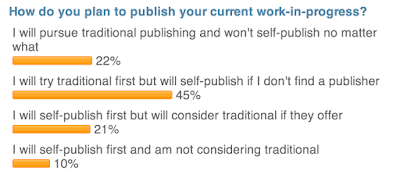
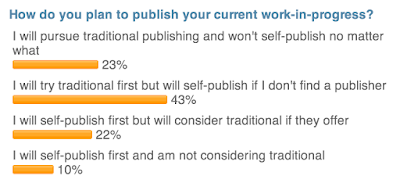







We Kickstarted the BAD KARMA hardcover and later offered it through Diamond (selling copies we had overprinted) via Dynamite.
My guess is we sold more copies through Diamond thanks to awareness of and response to the Kickstarter than we would have had we just offered it cold to the marketplace.
Kickstarters are a ton of work…I had to actually slow down on them a bit but picking back up in fall with a new one. The thing is you always have to look at your kickstarter as a store and try to offer the best product you can and show as much of it as you possibly can on your page. I love doing them because it creates a real connection with me and my audience and a certain kind of relationship that is just impossible to have anywhere else…but my point is that it is not an easy thing and you will judged by how well you communicate, and deliver a solid product. Like Todd says in this excellent piece, a lot of the after kickstarter income is made after the book is released and keeping digital as well as some of the books in stock like I do on the Paperfilms.com site is very important to those that might have missed the chance to become part of the kickstarter. As pictured, we have ABBADON now featured in the diamond catalogue under our partners Adaptive imprint and we are hoping word of mouth from the kickstarter helps its sales to a brand new audience.
[…] How To Make Crowdfunding Sustainable For Comics – A little while back … to your customer list each time. If you’re doing a series and you have some copies of the previous volume(s) in hand, offer a bundle of the whole series as an upsell. It can help you raise more … […]
[…] Crowdfunding | Todd Allen, author of The Economics of Digital Comics and veteran of several Kickstarter campaigns, discusses how crowdfunding fits in with the larger comics market — and how it could work better. [The Beat] […]
Standard 70 ain’t half bad. I use it for advance review copies and it’s noticeably less premium, but only if you’re comparing the book to offset-printed ones on your bookshelf. The print quality is nice and crisp, on bright white paper, and most people who look at them think they’re finished books until I tell them they aren’t.